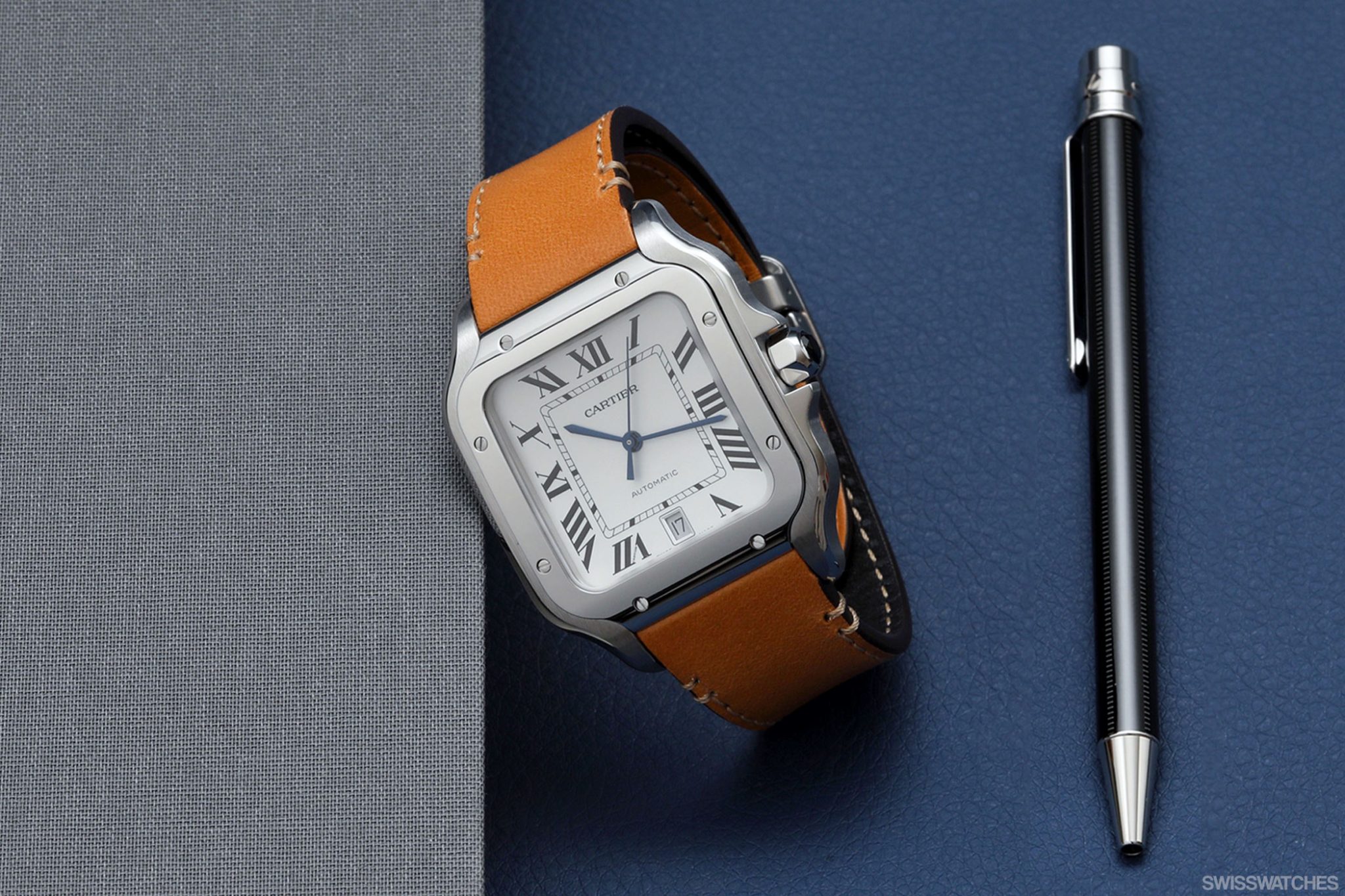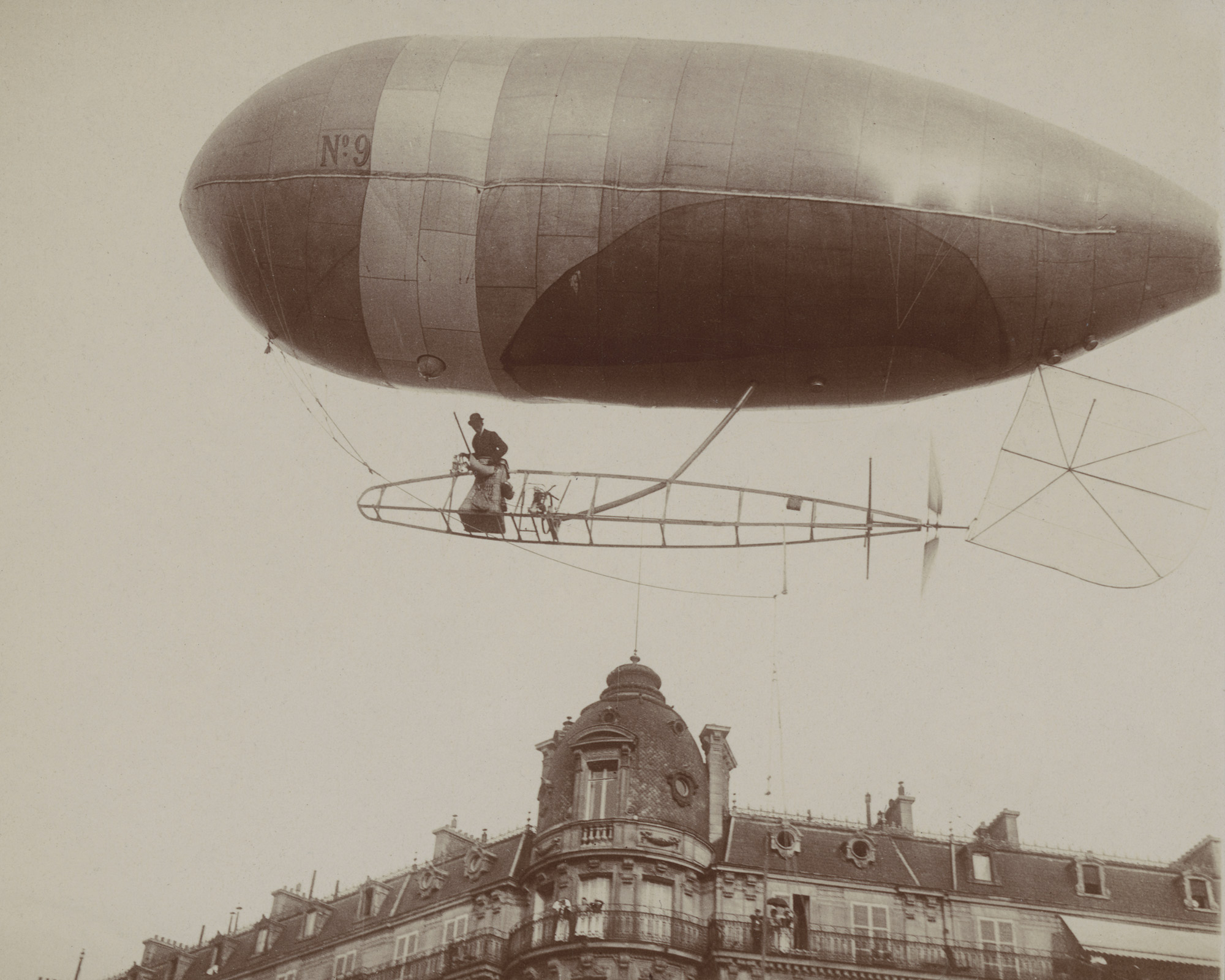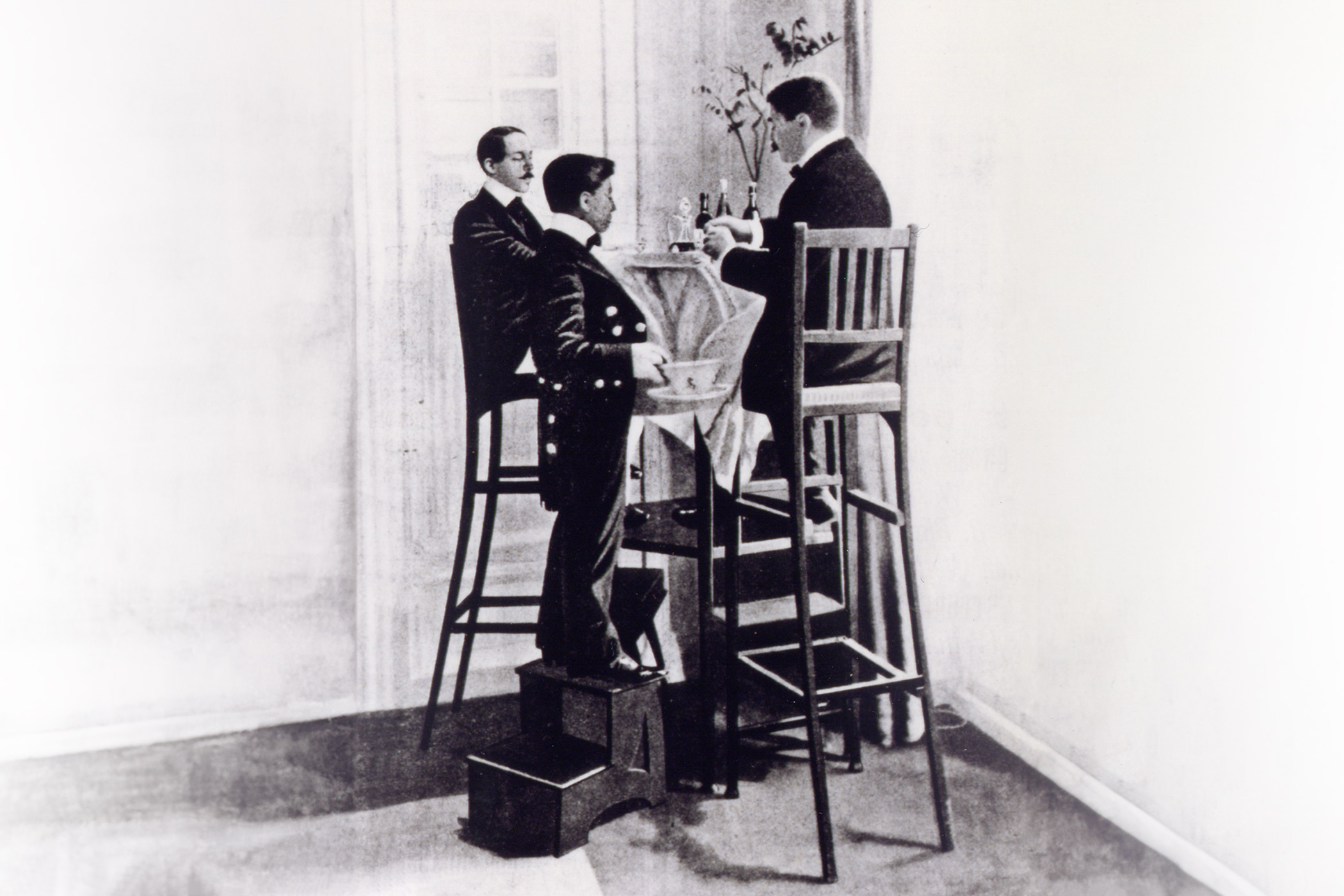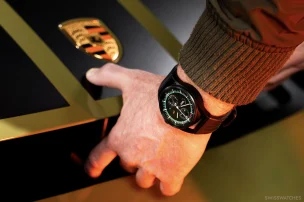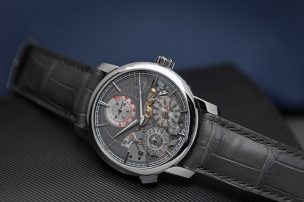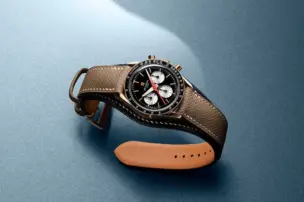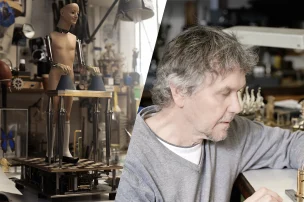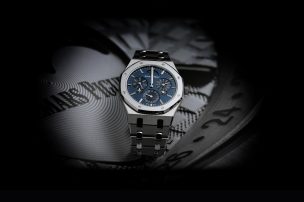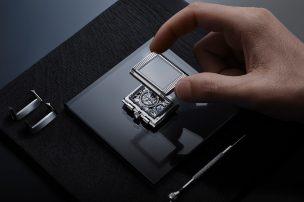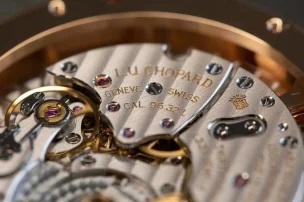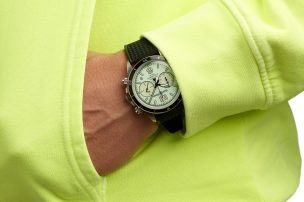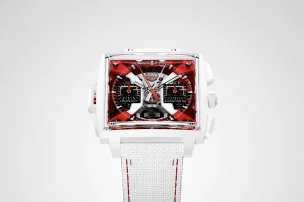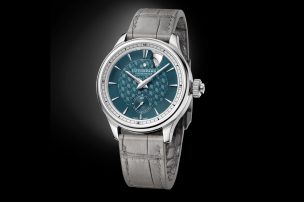
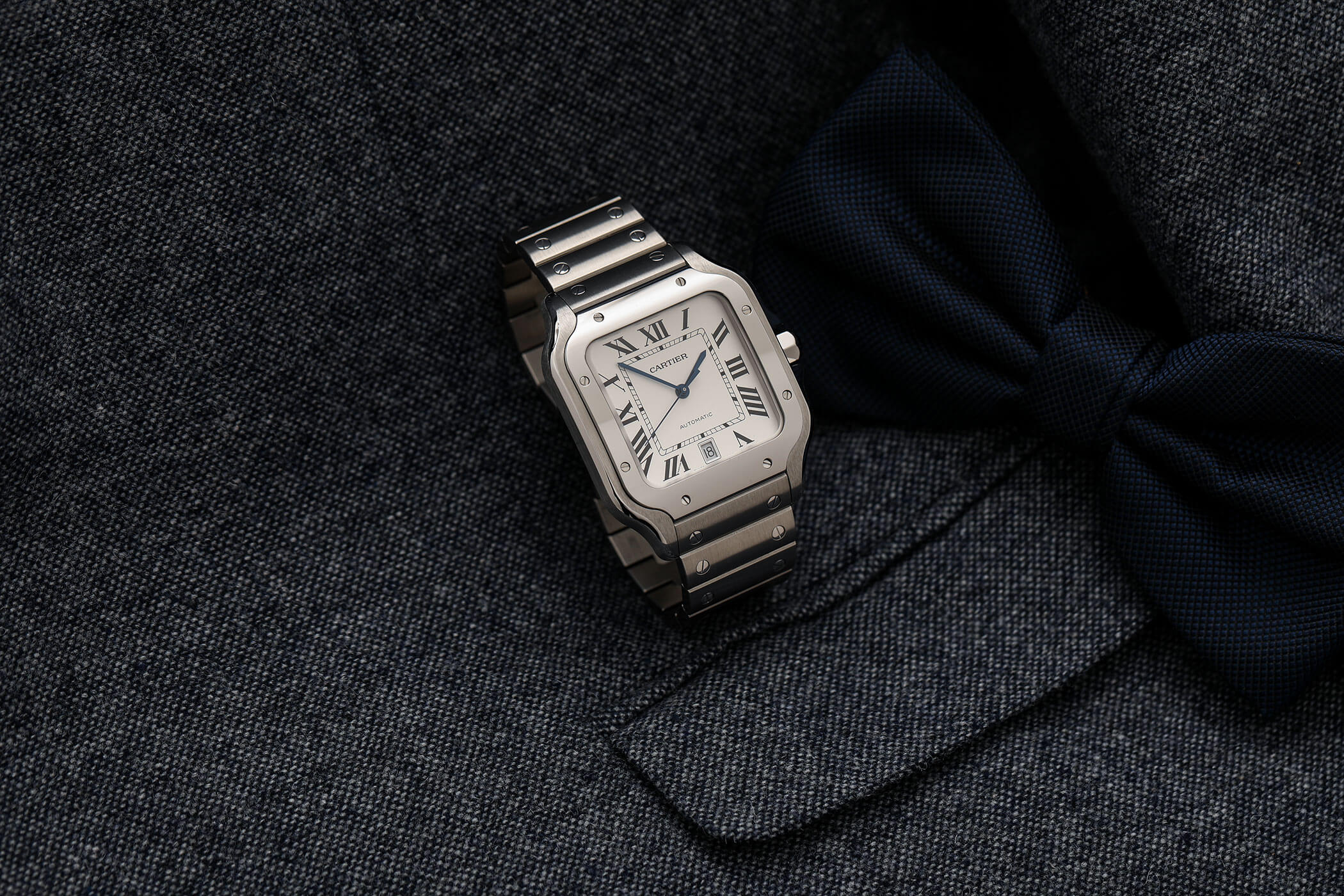
How the Cartier Santos Took Flight
Whether donned as a mark of distinction or simply to appear in-vogue, wristwatches are considered an indispensable companion for many a gentleman. Be it glowing in gold or shining in stainless steel, round or square, sporty or elegant – the timepiece a man wears on his wrist has become synonymous with one’s sense of self, and even an expression of one’s personality. But how exactly did the wristwatch become a daily companion and how did the Cartier Santos contribute?
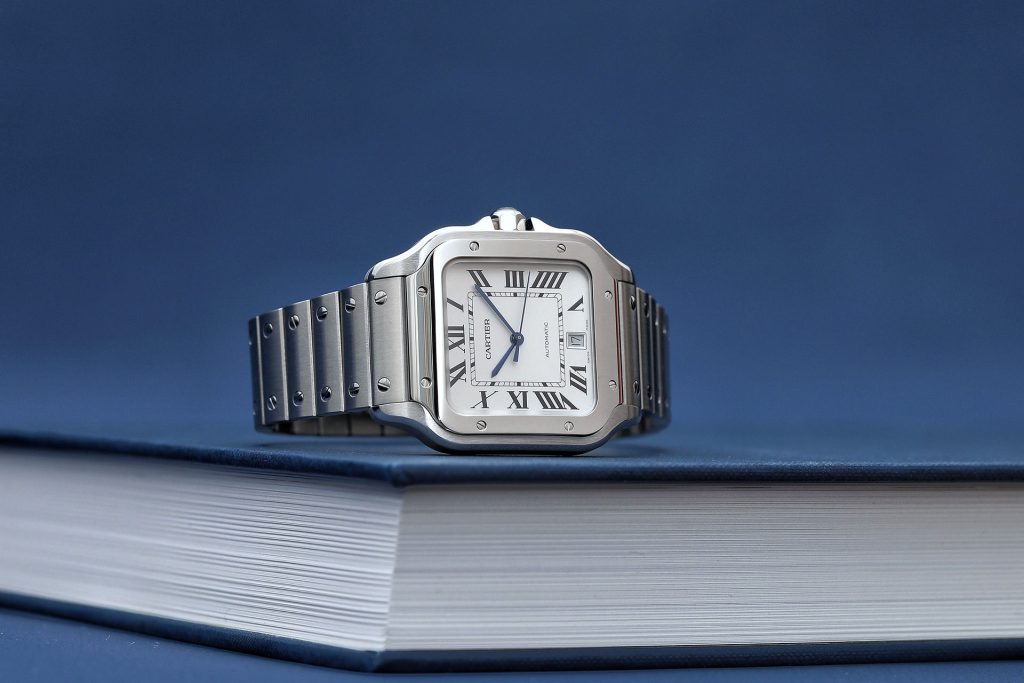
To understand the history of the wristwatch, it is worth casting our eyes towards the city of Paris, where Louis Cartier created a wristwatch for his friend and Brazilian aviation pioneer Alberto Santos-Dumont at the beginning of the 20thcentury. With its avant-garde design and integrated lugs, the Cartier Santos is considered one of the first ‘modern’ wristwatches and the first to be marketed commercially. Today, the square-shaped watch is a timeless icon of the maison.
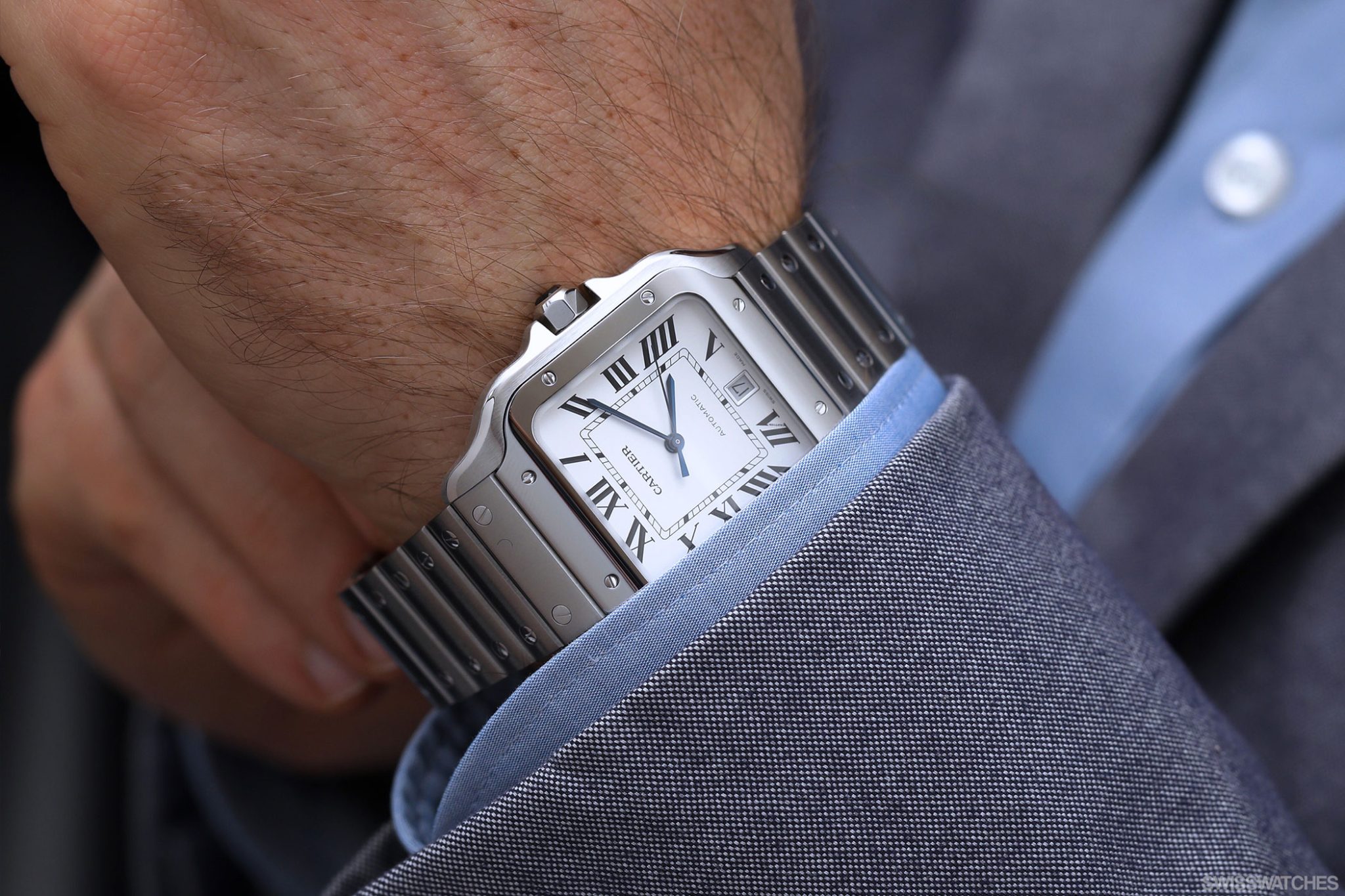
Let’s take a closer look at how the eccentric Alberto Santos-Dumont sparked the idea for the wristwatch, what makes the Santos’ design so unique, and why the watch has remained so popular to this day. Let’s embark on a horological journey, starting in the French capital at the turn of the century and ending on the red carpet of the Met Gala.
The birthplace of the Santos: Paris
The City of Love, Capital of Fashion, Centre of Art – Paris has many epithets that do not come by chance. Its landmark, the Eiffel Tower, was presented at the World’s Fair in 1889. Designed by Gustave Eiffel, the impressive 106-storey steel structure was the tallest building in the world at the time. It embodied the significant changes that led to modernity.

Credit © Unsplash
The ‘first globalisation’ (ca.1880-1914) and the second industrial revolution brought forth many technological advances, such as the invention of the telephone, the light bulb, photography, or the opening of the first underground stations. As machine production was established and factories were built, the city attracted more and more people. So much so, that during the second half of the 19th century, the population of Paris grew to more than one million. Furthermore, many travellers from abroad came to Paris to marvel at the latest trends and to buy precious clothes and jewellery.
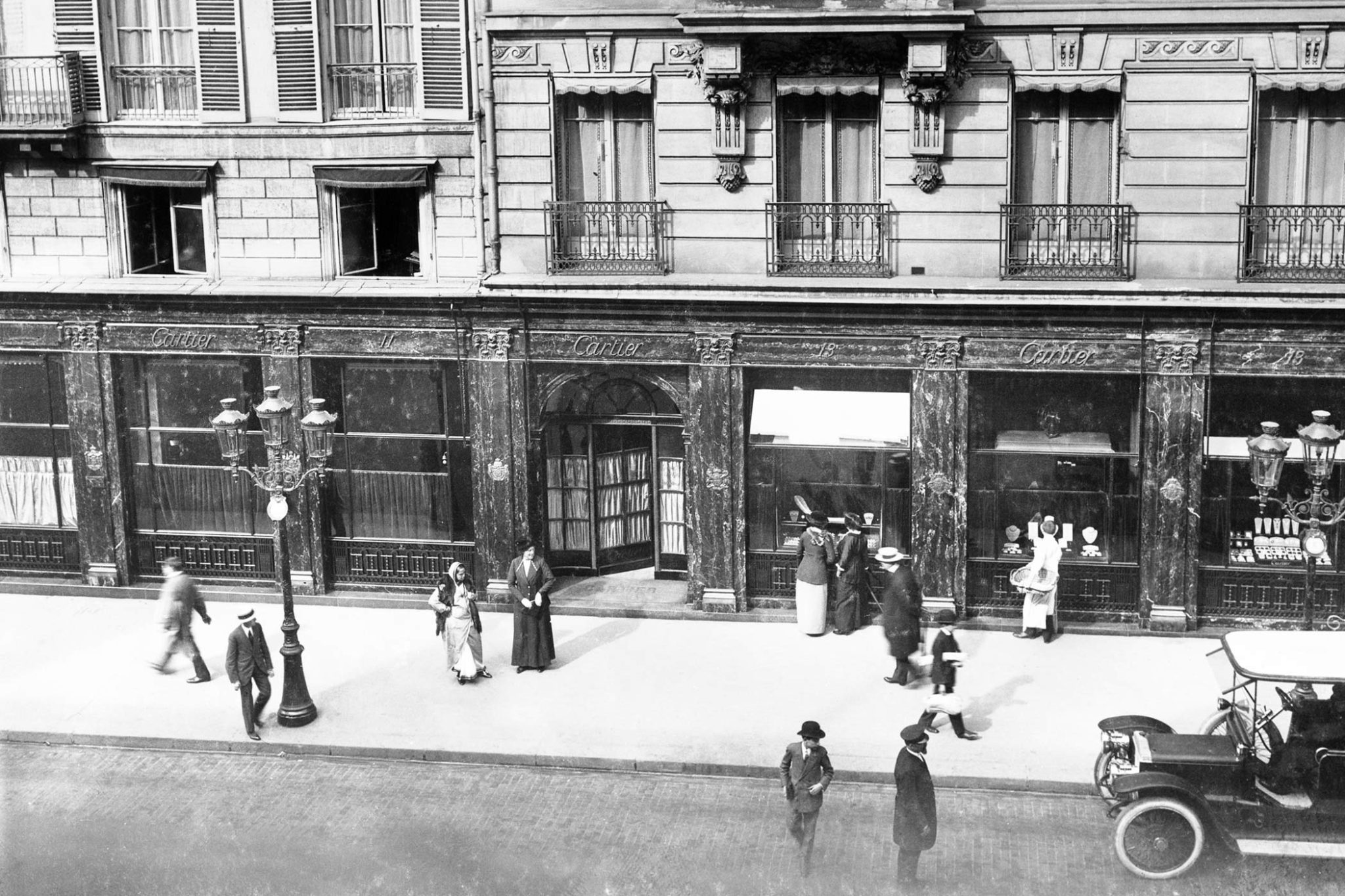
The Cartier Boutique in Paris, circa 1912/1913
Credit © Cartier
In 1892, the young Alberto Santos-Dumont moved from Brazil to the French metropolis. In Paris, his vibrant personality would not only technologically advance aviation, which was still in its infancy, but also significantly shape the world of fashion and watches.
Aviation pioneer: Who was Alberto Santos-Dumont (1873-1932)?
As the sixth of eight children, Alberto Santos-Dumont was born in Brazil in 1873. There, his father Henrique Dumont, the son of French immigrants, had mechanised the production of coffee. Thus, he had made a name for himself as the ‘King of Coffee’ thus enabling Alberto to come into contact with the machines on the coffee plantations from an early age. As a child, Alberto had already developed a sense of adventure and a fascination for technology. At the age of seven, he drove steam-powered machines around the plantations. As a ten-year-old, he started experimenting with steam and filling paper balloons with it. Furthermore, Alberto enjoyed reading and was particularly fond of Jules Verne’s adventure novels. When he was 15 years old, Alberto observed a balloon flight in São Paolo, which ignited his passion for flying. But it would be some time before he flew a balloon.
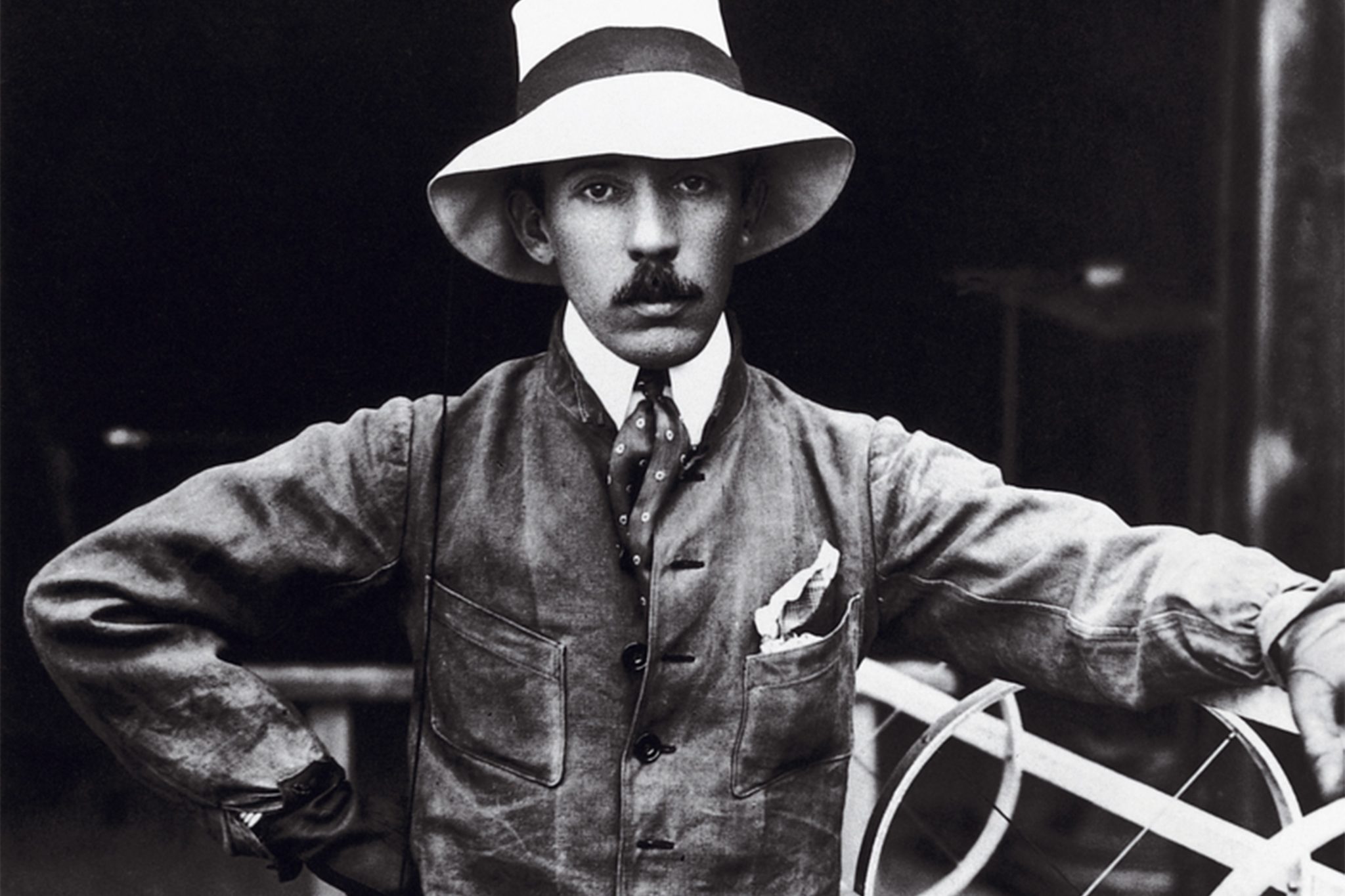
Alberto Santos-Dumont, circa 1907/1908
Credit © Cartier
After suffering from a one-sided paralysis caused by an accident, Henrique Dumont wanted to see his children well looked after. Thus, Alberto received his inheritance, equaling half a million dollars, in advance and was sent to Paris to study mechanics in 1892. This is where Alberto began turning his passion for aviation from daydream into reality.
Inspired by the book Andrée and his Balloon about the Swedish explorer Salomon Andrée, who tried to reach the North Pole by balloon, Alberto sought out the workshop of the book’s authors and balloon makers Henri Lachambre and Alexis Machuron in Paris. Accompanied by Machuron, Alberto undertook his first hot air balloon flight from Vaugirard in Paris to Château Ferrières. The journey lasted two hours and covered 100 kilometres. This experience gave Santos-Dumont a fresh impetus to learn how to fly and build his own aircraft. With the help of the two balloon builders, Santos-Dumont learned how to manoeuvre a hot air balloon and assemble his very first lightweight balloon, which could carry one person: the Brésil.
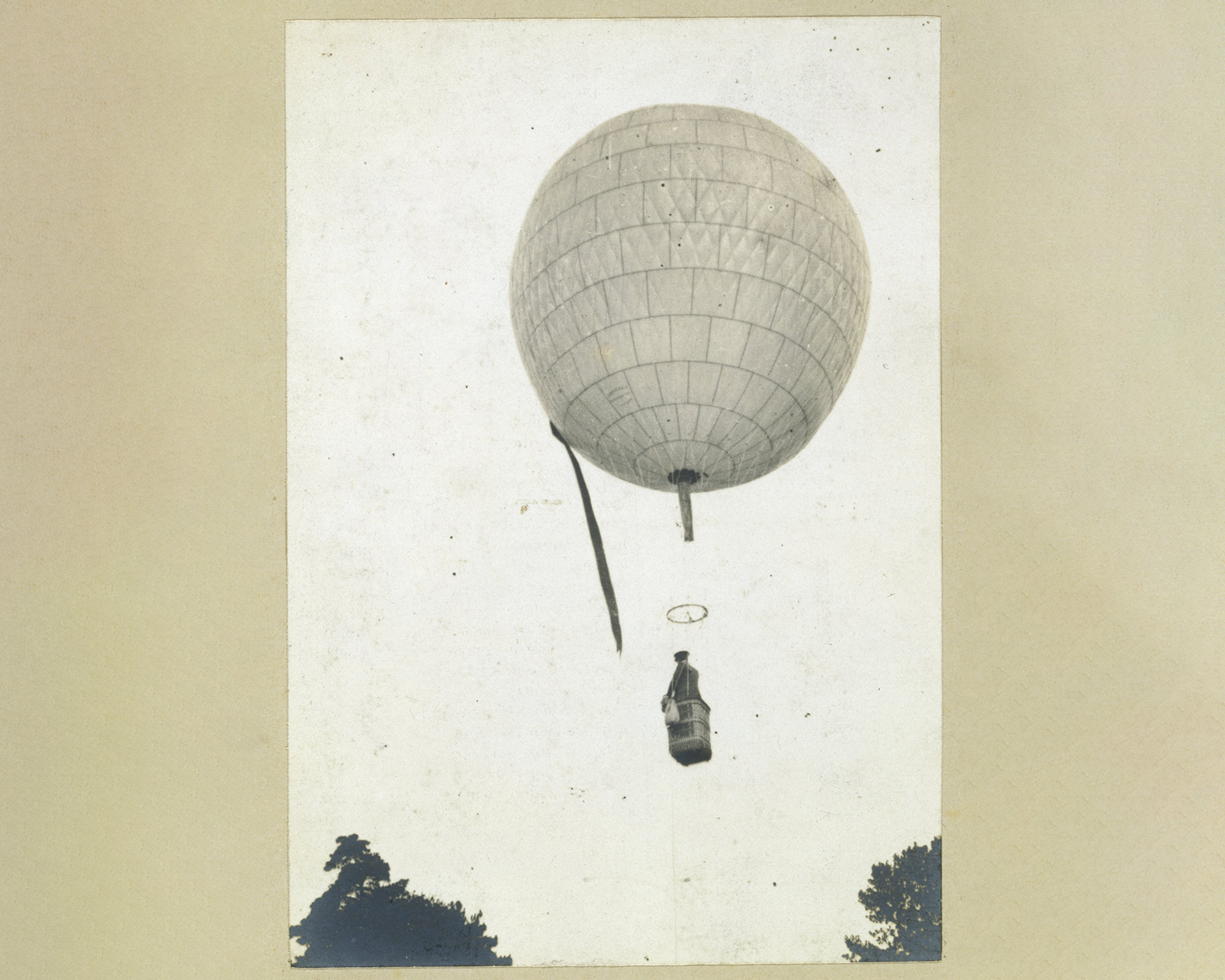
Santos-Dumont in his hot air balloon
Credit © Cartier
After successfully flying his hot air balloon in front of a large audience, Alberto began looking more intensively into aviation and constructing his own aircraft. He quickly turned away from hot-air balloons and towards machine-powered blimps. Between 1898 and 1905 he created 14 of them. Most consisted of a hydrogen-filled balloon with a cigar shape reminiscent of a zeppelin and attached to an engine. They were powered by steam, batteries and later – taking inspiration from automobiles – by petrol. Santos-Dumont successfully flew his first airship from the Botanical Gardens to the west of Paris on 20 September 1898, reaching an altitude of 396 metres.
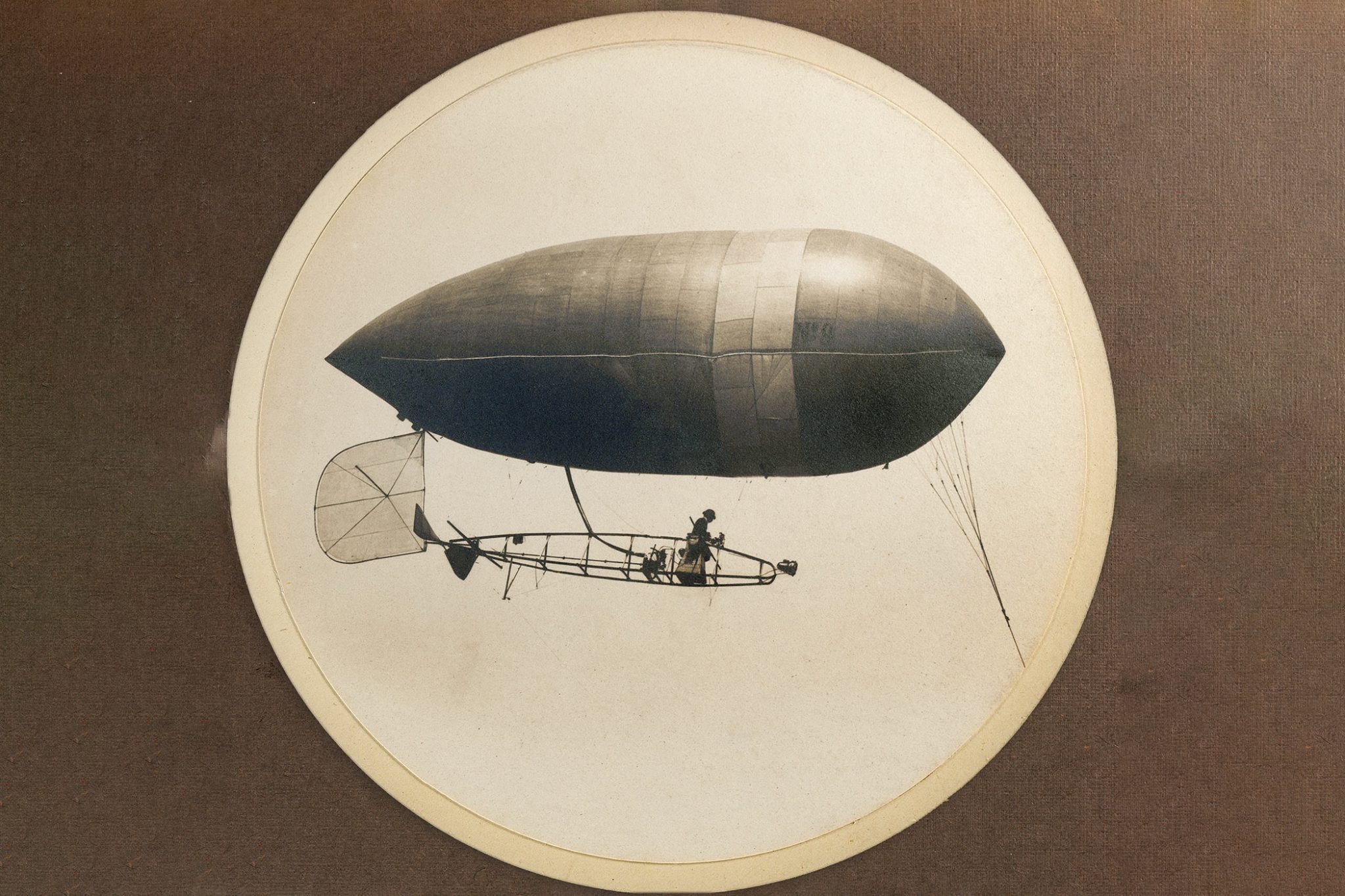
Credit © Cartier
The same year, aviation enthusiast Ernest Archdeacon founded the Aéro-Club de France. At the club, aviation was debated, and significant advancements were initiated through competitions. In April 1900, another important club member, the oil magnate Henri Deutsch de la Meurthe, called for the first competition. Whoever was the quickest to steer their airship from St. Cloud in the south-west of Paris to the Eiffel Tower, circle the tower, and return within half an hour should receive a prize of 50,000 francs.
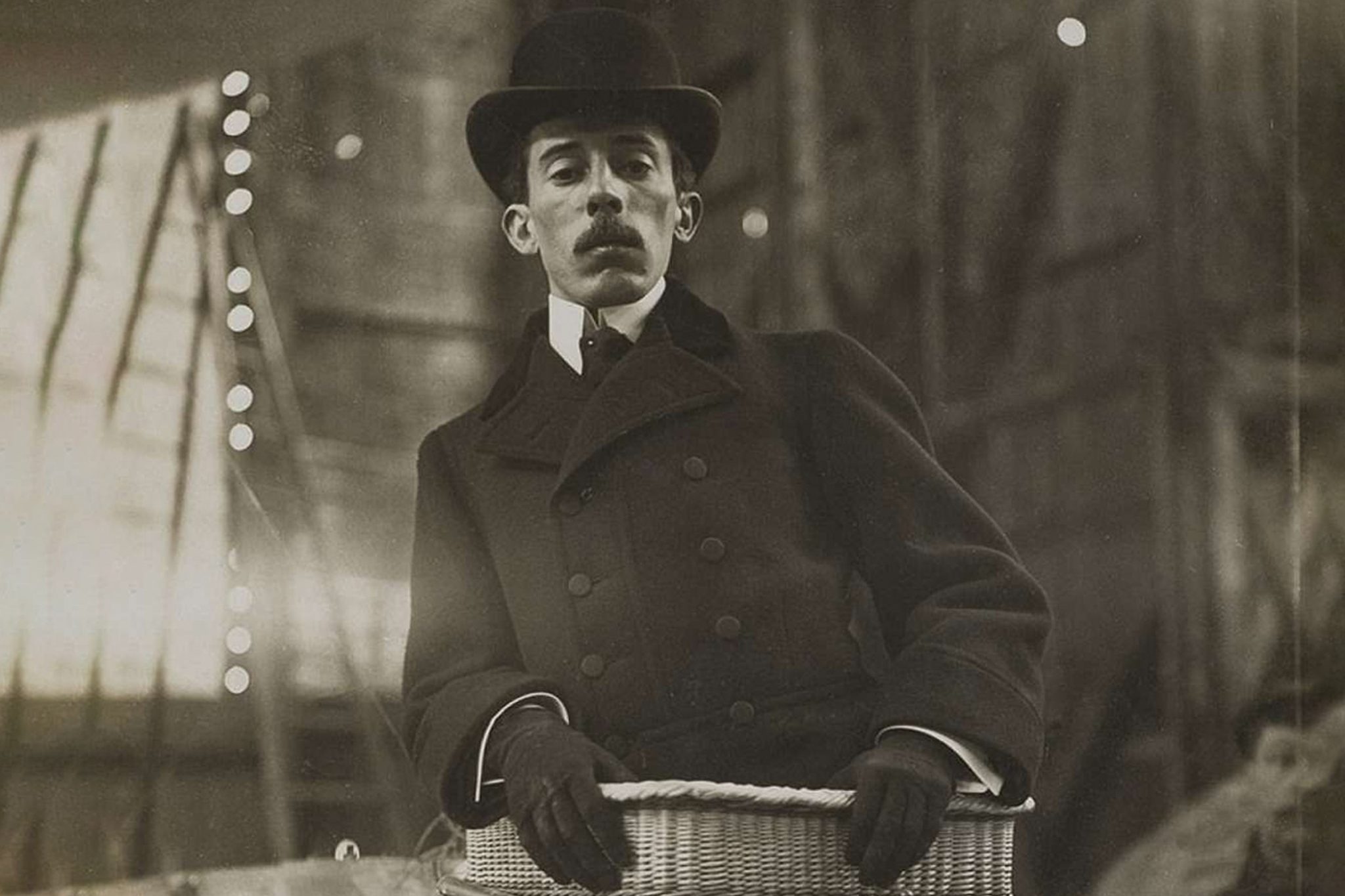
Credit © Cartier
Needless to say, Alberto Santos-Dumont took up the challenge and even set up a hangar near St. Cloud for that purpose. In July, he conducted several test flights with a hydrogen-powered dirigible, reaching the Eiffel Tower but taking too long – 40 minutes – to win. On 8 July, he crashed into the Trocadero Hotel with his dirigible No. 5. Leaking hydrogen caused an explosion. Luckily, Santos-Dumont got off lightly. On 19 October 1901, Santos-Dumont completed the 11-kilometre route in his airship No. 6 despite challenging weather conditions. However, as he needed an additional 40 seconds to the specified time, the jury initially did not want to award him the prize. Due to the strong encouragement from the audience, however, Santos-Dumont was awarded the prize after all. He donates the money to his staff and Paris’ people in need.
After a failed attempt to fly across the sea in 1902, Santos-Dumont turned his attention to powered aircraft. The following year, he showed the Cuban American Aida de Acosta how to navigate an airship and let her steer his motorised dirigible No. 9. Thus, Aida became the first woman to pilot a powered aircraft. She did so six months before the brothers Orville and Wilbur Wright successfully flew their aeroplane Flyer at Kitty Hawk, North Carolina, in the United States.
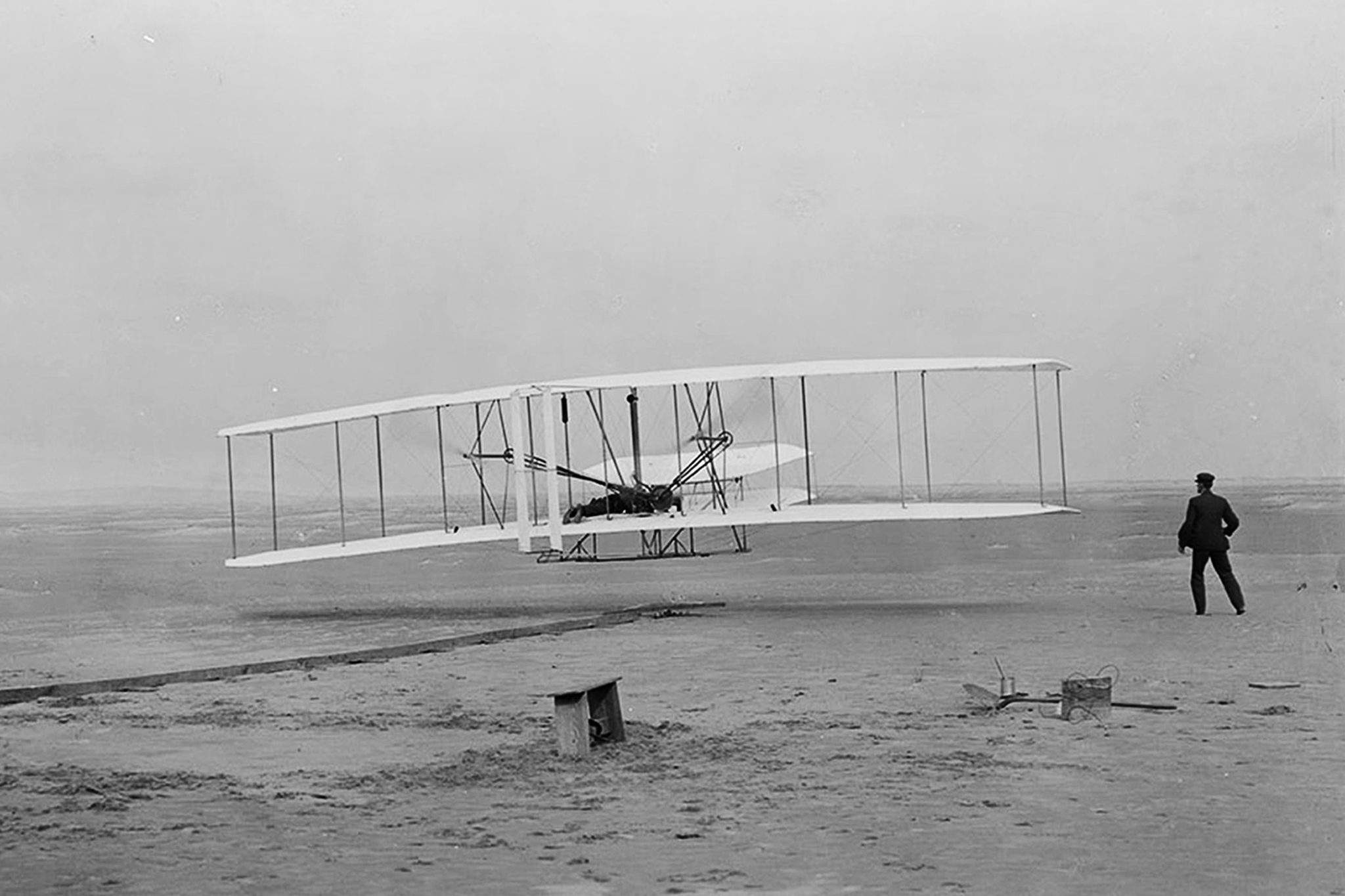
Orville Wright steering the powered aircraft Flyer, while his brother Wilbur watches
Credit © Cartier
After two years of development, Santos-Dumont soared through the air with his light aircraft 14-bis and travelled a 60-metre distance on 12.11.1906. The biplane consisted of a bamboo and pine construction with silk fabric stretched over its wings, akin to a box kite. Santos-Dumont thus received another award from the Aéro-Club, the Deutsch-Archdeacon Prize. For the time being, he was considered the inventor of the aeroplane. This was because the Wright brothers secretly carried out their flights and patented their machines. It was not until 1908 that the American siblings presented their aircraft in France and, in time, replaced Santos-Dumont as the ‘inventor of the aeroplane’.
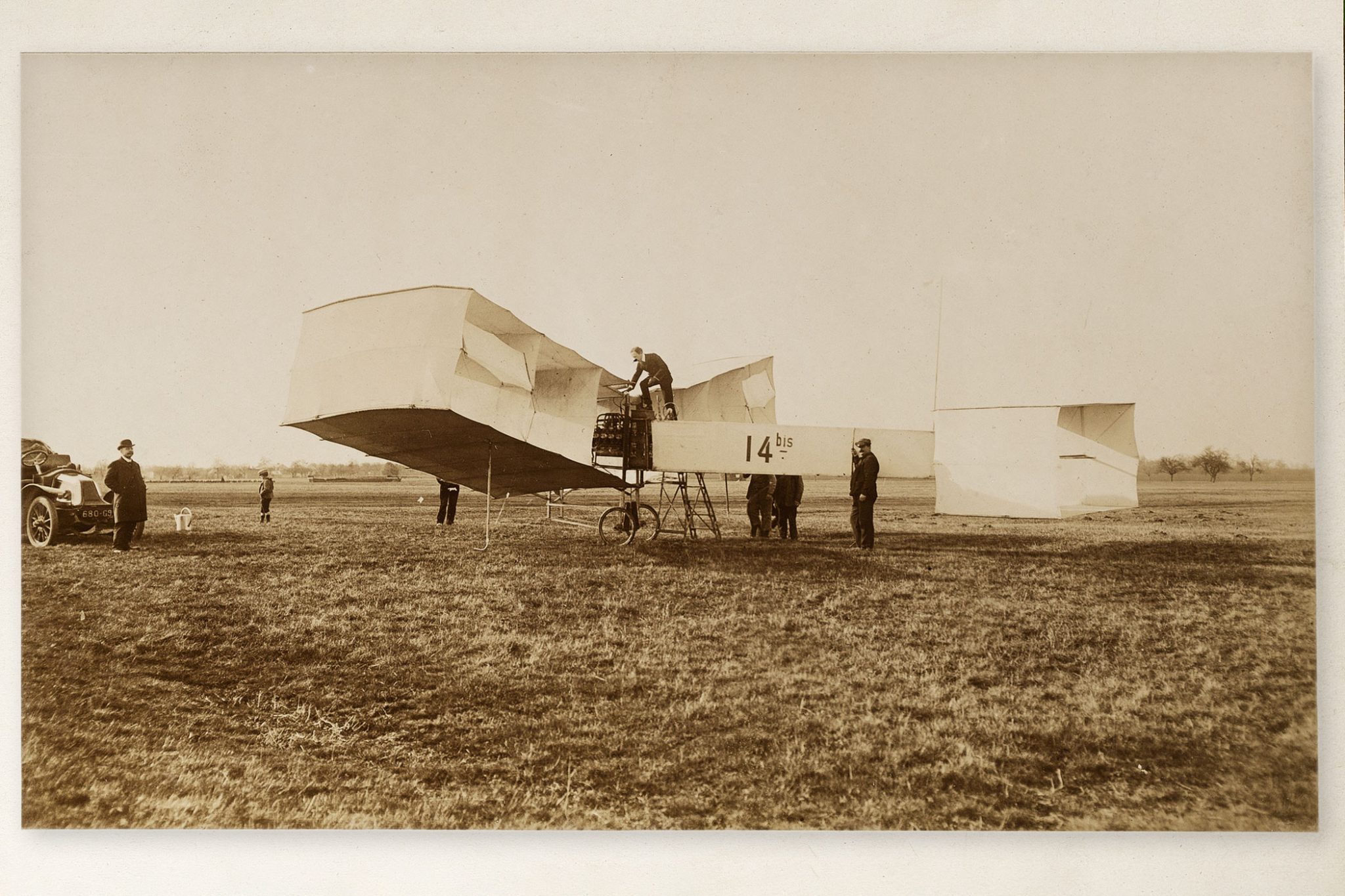
Alberto Santos-Dumont and his 14-bis
Credit © Cartier
Santos-Dumont continued to tinker with his aircraft. In November 1907, he flew his ultra-light aircraft No. 19, the Demoiselle, with a cruciform tail over the Seine. In cooperation with the Clement Bayard company, Santos-Dumont launched the monoplane as the first commercially produced aircraft in 1908. He produced further models of this type in series up to machine No. 22. In 1909, the machine could already reach speeds of up to 120km/h.
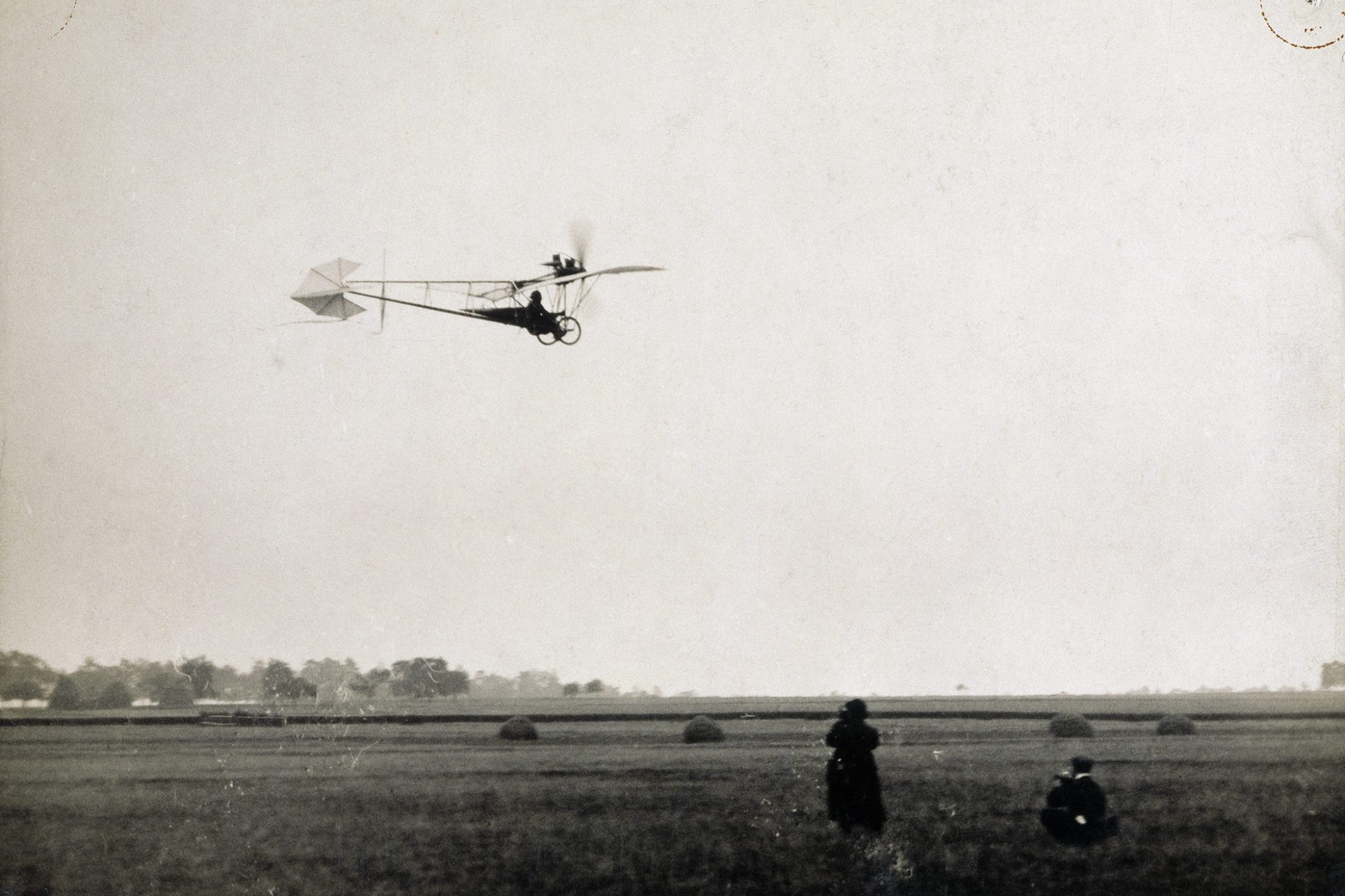
Credit © Cartier
In 1910, the aviation pioneer quit flying after an accident with the Demoiselle in January but remained a luminary in the world of aviation until the beginning of the First World War. However, he suffered from multiple sclerosis and depression, leading to his withdrawal from the public eye. In the years that followed, Santos-Dumont spent a lot of time in French and Swiss sanatoriums and worked on inventions, some of them daring. Time and again, he was plagued by the thought that his invention had been used in the war. In 1932, Alberto Santos-Dumont took his own life. Nowadays, his heart is being kept in a golden globe in the Brazilian National Aerospace Museum.
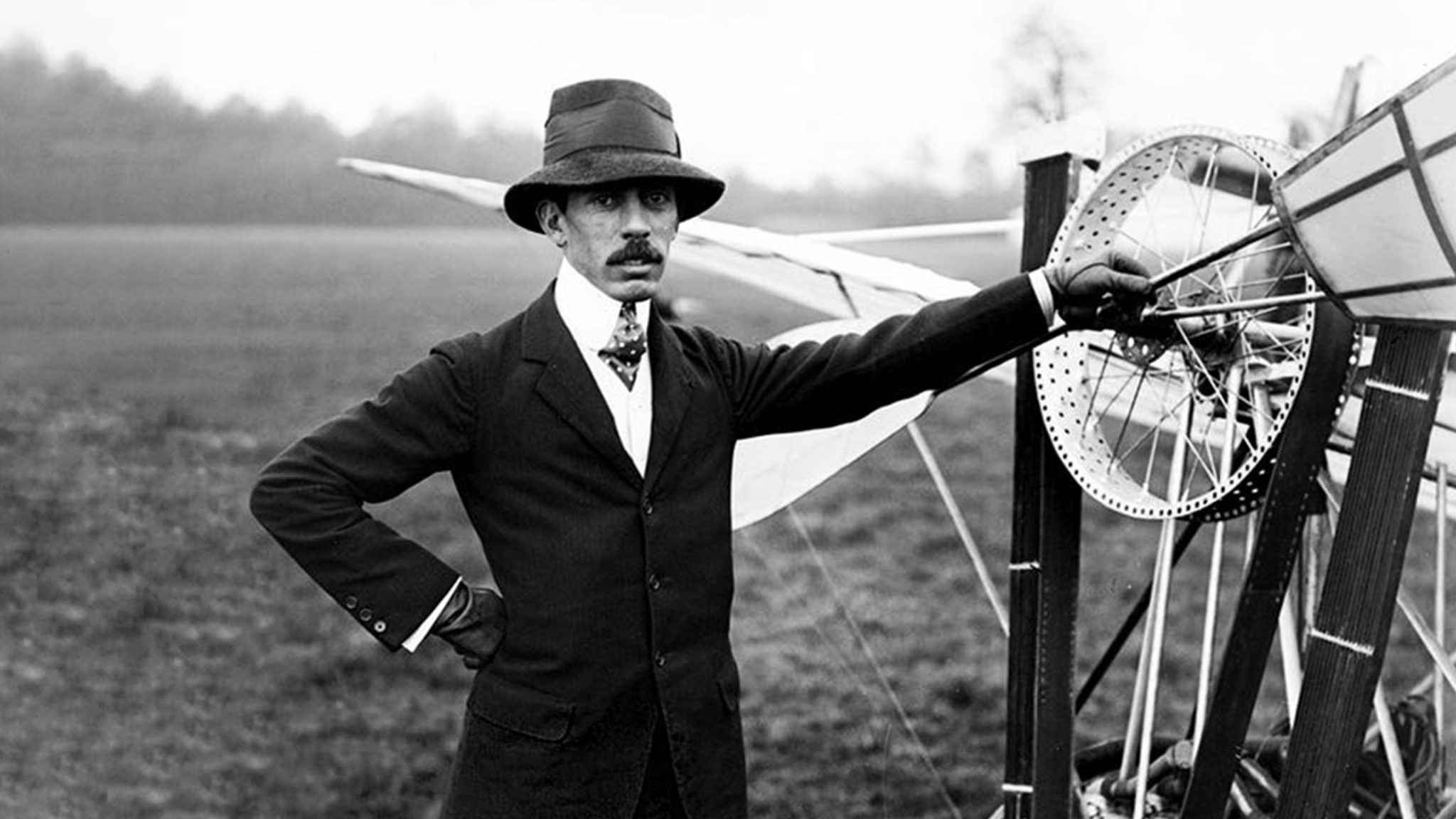
Credit © Cartier
Unfortunately, the exact design of Santos-Dumont’s airships is unknown as he never patented his inventions and burned all his papers and plans after being mistaken for a German spy. Nevertheless, his adventurous spirit still lives on in the form of the Cartier Santos today.
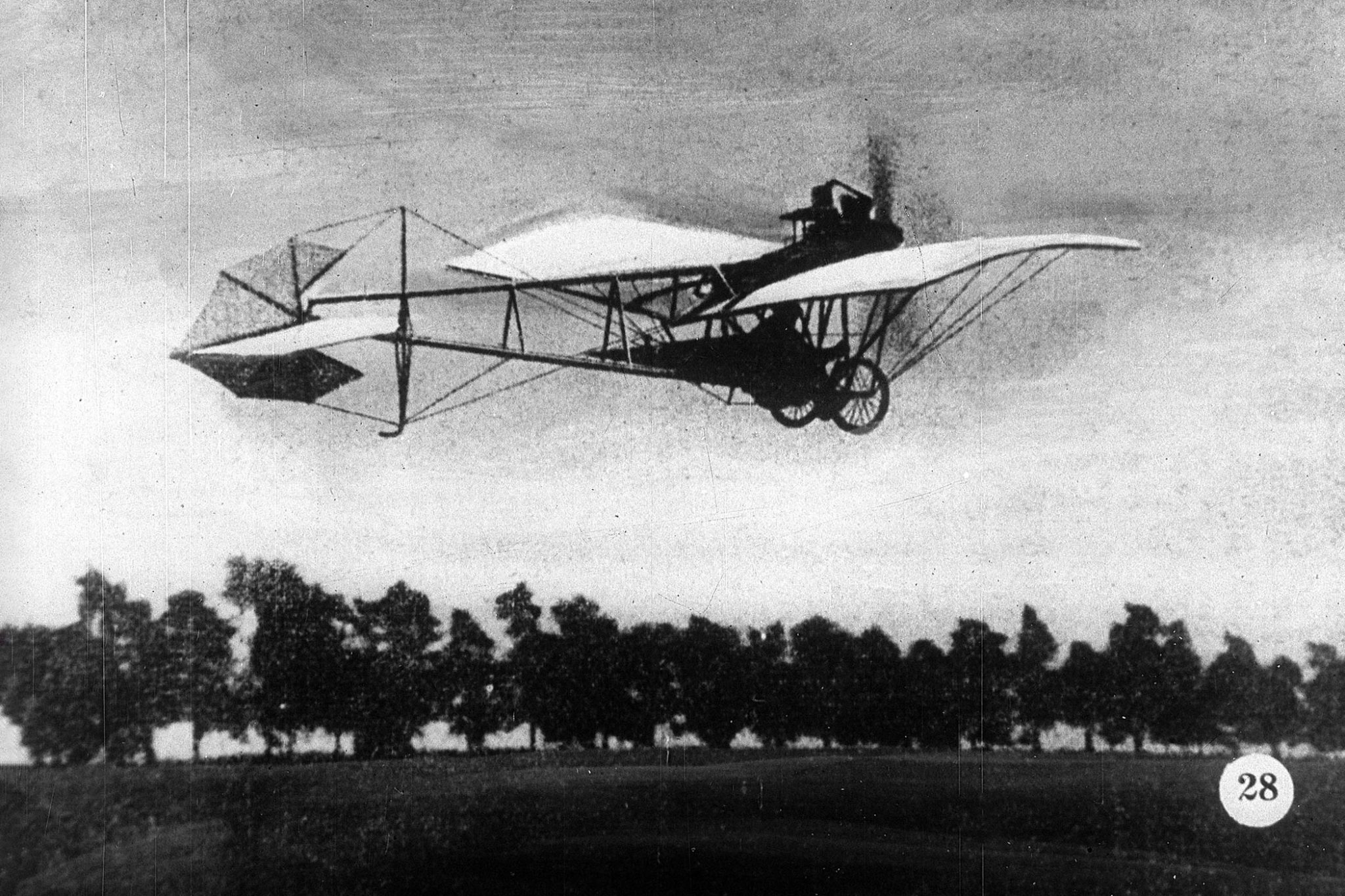
Credit © Cartier
When two Pioneers meet: Santos-Dumont and Louis Cartier
During his lifetime, Santos-Dumont was well-known in Paris for his airships and eccentric sense of style. Due to his petite stature of 1.52 metres, the Brazilian aviation pioneer had also made a name for himself as ‘Le petite Santos’. He could often be seen flying through the city in his airship Baladeuse, tying it to a lamppost with a rope to visit his friends or go to the café. His friends included many influential people, such as Gustave Eiffel, members of the Rothschild family, and the widow of Napoleon III. Santos-Dumont liked to invite them to his home and hosted dinners where the guests sat on two-metre-high chairs to experience the sensation of flying.
Alberto Santos-Dumont with his blimp Baladeuse (left), Alberto Santos-Dumont dining with a friend around 1900 (right)
Credit © Cartier
It was probably through the Aéro-Club that Santos-Dumont met the jeweller and watchmaker Louis Cartier at an evening event between 1898 and 1900. The two shared an affinity for technology and innovation: Alberto Santos-Dumont was driving aviation forward with his inventions, while Louis Cartier was revolutionising his family business. Therefore, it is no surprise that the two were to have a conversation whose outcome would make wristwatches what they are today.
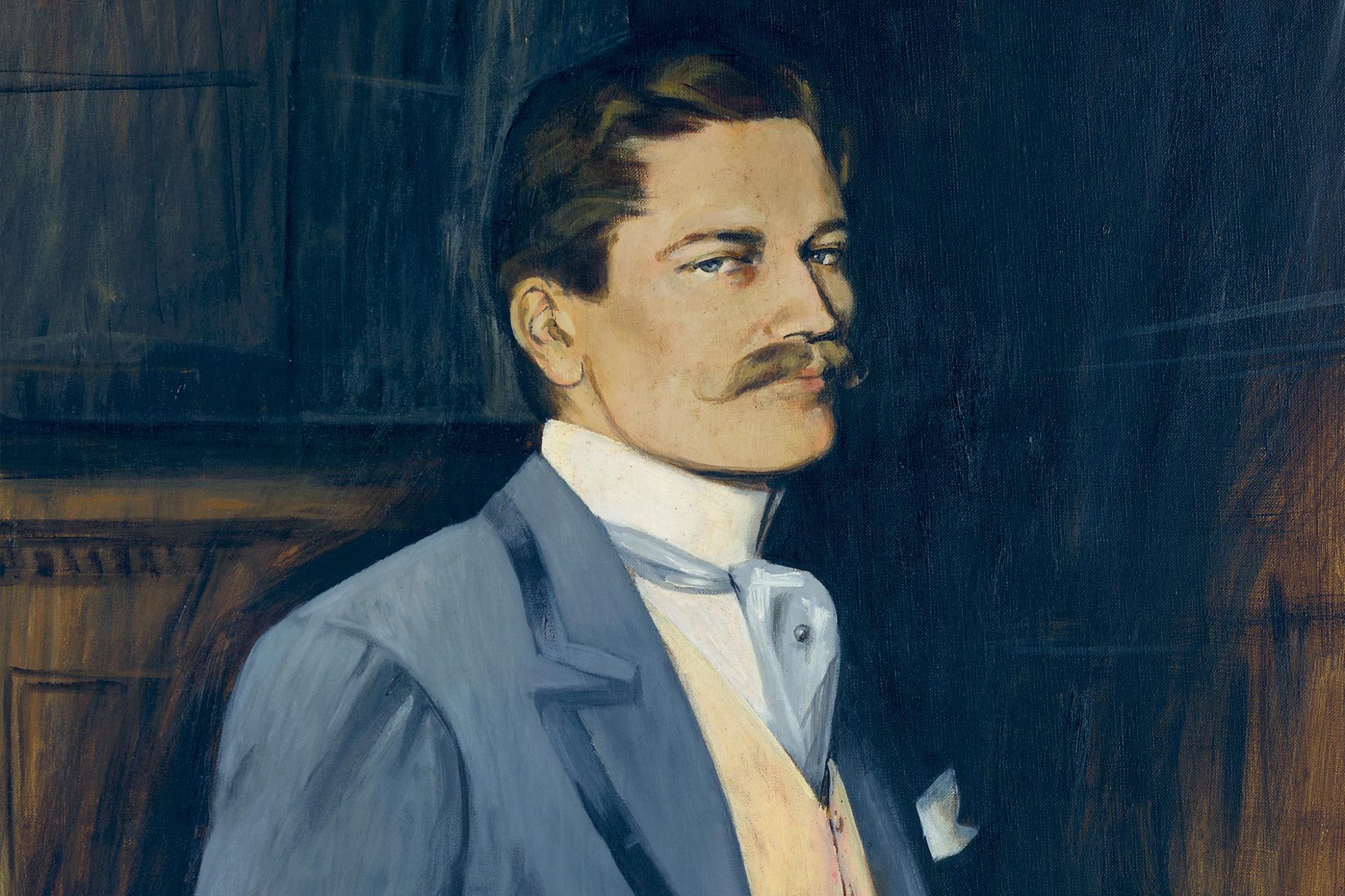
A painting from 1904 showing Louis Cartier
Credit © Cartier
Legend has it that Alberto Santos-Dumont told the jeweller that a pocket watch was not practical for aviation and that there had to be a better solution as the Aéro-Club’s competitions were not only about distance, but also about time. However, navigating an airship required both hands and taking out a pocket watch was highly risky. Therefore, it was difficult for pilots to keep track of time during a flight. So, after he had been made aware of this problem, Louis resolved to find a way for his friend to get around it.
Origins and challenges of the wristwatch
Strictly speaking, wristwatches already existed at the turn of the century. They had been fashionable for women for a long time. For example, Abraham-Louis Breguet created a wristwatch for the Queen of Naples in 1810, and Patek Philippe made one for the Hungarian Countess Koscowicz in 1868. As beautiful as the filigree wristwatches were, they were not particularly precise. Therefore, they were considered jewellery, having been part of Cartier’s permanent assortment since 1888.
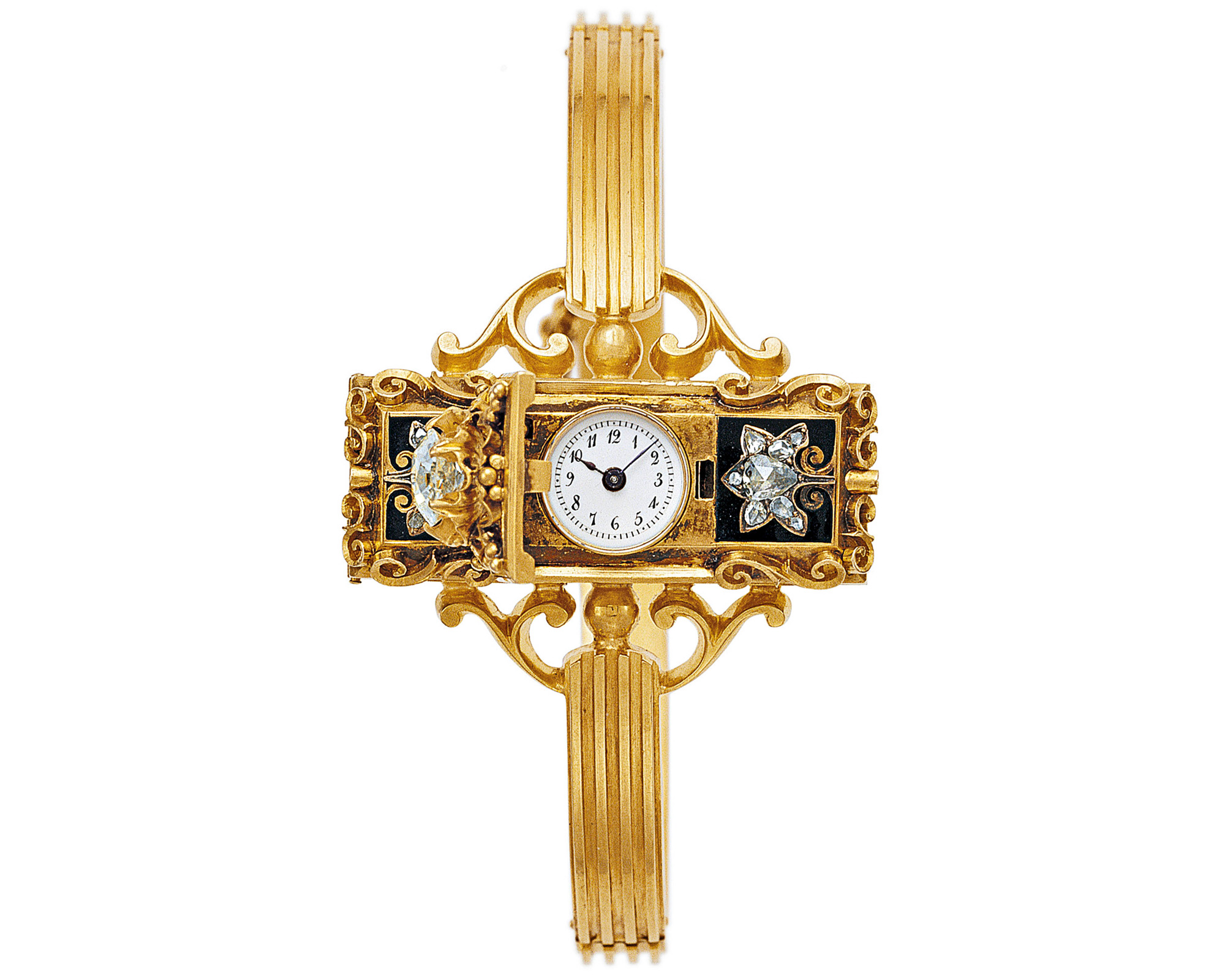
Patek Philipp’s diamond-set bangle watch for the Hungarian countess
For men, on the other hand, there had been no commercial wristwatches. Girard-Perregaux, for example, produced a series of 2,000 wristwatches for Prussian naval officers commissioned by Wilhelm I in 1880, but these were custom-made watches and not meant for the public. In 1892, Audemars Piguet launched the first wristwatch with a minute repeater, but even then, the concept of the gentlemen’s wristwatch failed to take off.
At the beginning of the 20th century, men wore their watches on a chain by their chest or in their trouser pockets. Launching a wristwatch for men posed two challenges. The first is a technical one, as the movement must function in different positions and, unlike pocket watches, not only in a vertical one. In addition, the movement has to withstand temperature fluctuations and other external influences, such as water. Moreover, adjusting the watch with one hand while wearing it had to be possible.
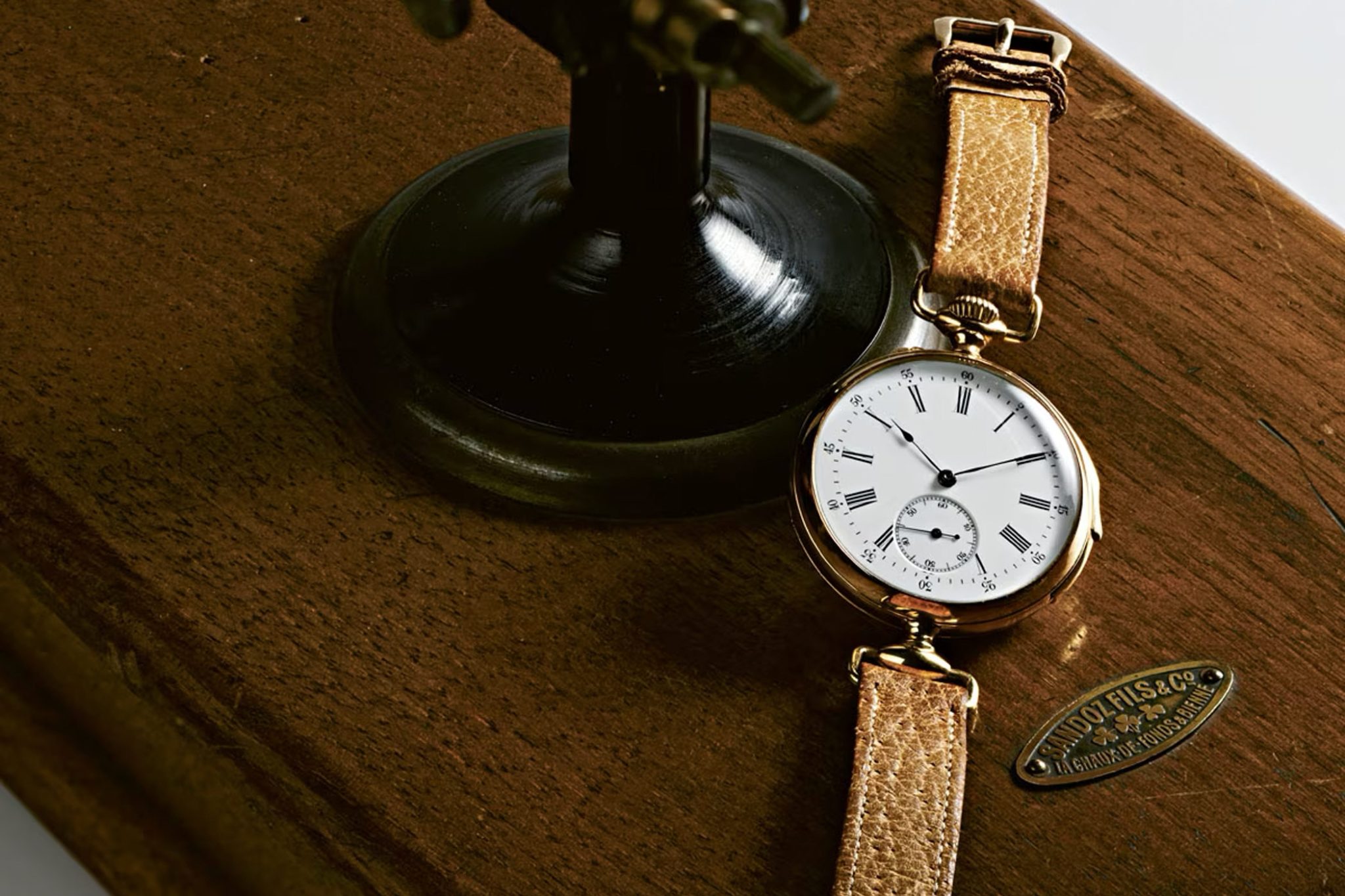
Wristwatch with minute repeater by Audemars Piguet
Credit © Omega
While these issues had already been solved for the most part, the biggest challenge was to make the wristwatch appealing to men. The wristwatch had to be freed from its image as women’s jewellery as it was only acceptable for pilots, soldiers, and athletes to wear a wristwatch without calling their style into question. Thus, it came down to aesthetically attaching the bracelet to the case so that it would be regarded as masculine.
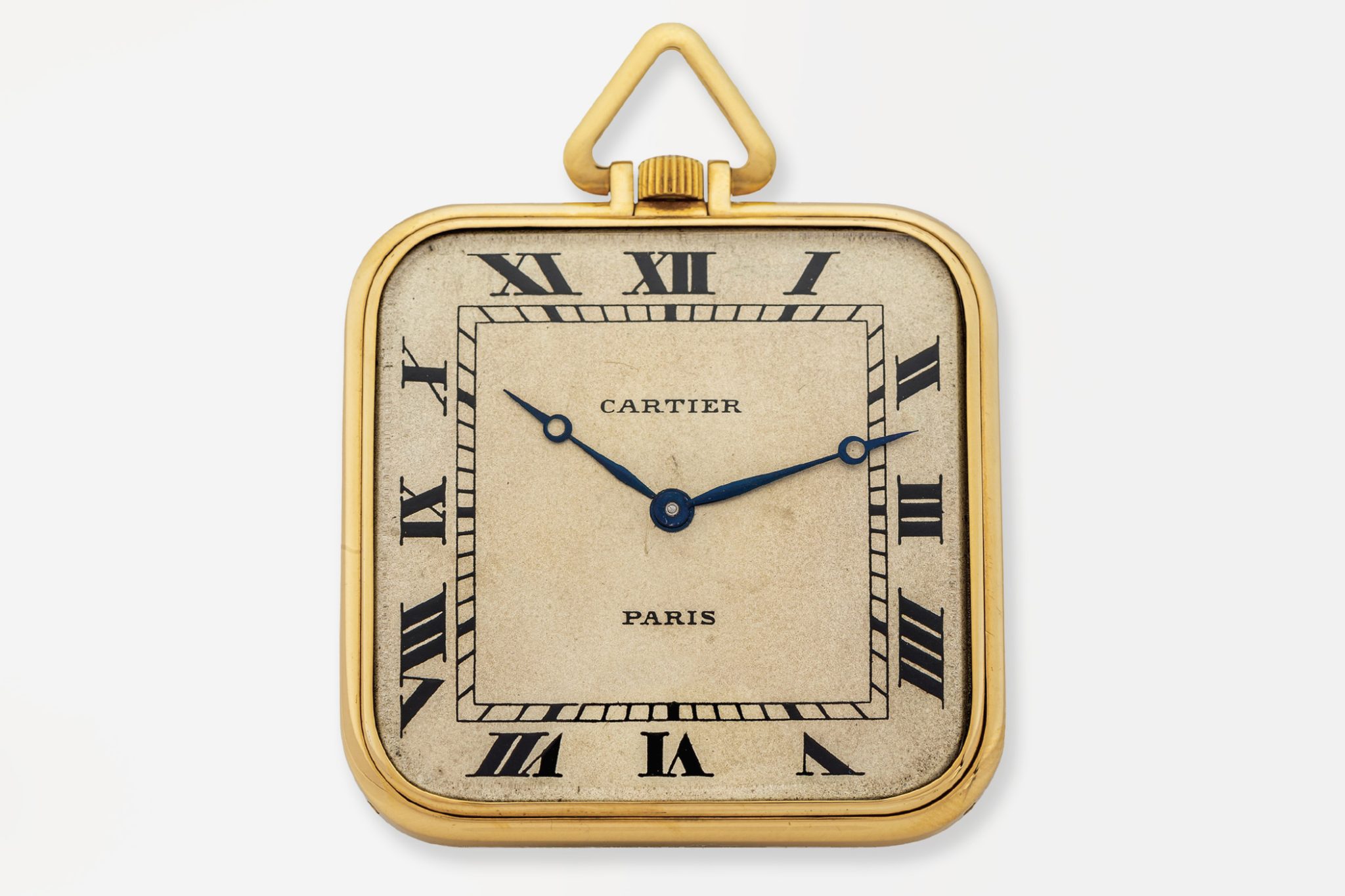
Credit © Antiquorum Genève SA, 2023
The original Cartier Santos
It is impossible to pinpoint when Louis Cartier gave the watch to his friend as there are no documents revealing the exact dating of the watch. However, an advertisement from the end of the 1970s (1978) refers to the year 1904, and this remains the commonly accepted date. According to the advertisement, Santos-Dumont received his first wristwatch from his friend Louis in 1904 and could finally read the time while steering his aircraft without any risks. Two years later, the Brazilian pioneer wore the watch on his 220-meter flight with the 14-bis in Paris on 12 November, accomplishing the first official powered flight. Naturally, such a ground-breaking event was diligently documented by press photographs. Thus, the watch did not only fulfil its purpose, but it also became a fashion statement thanks to Santos-Dumont.
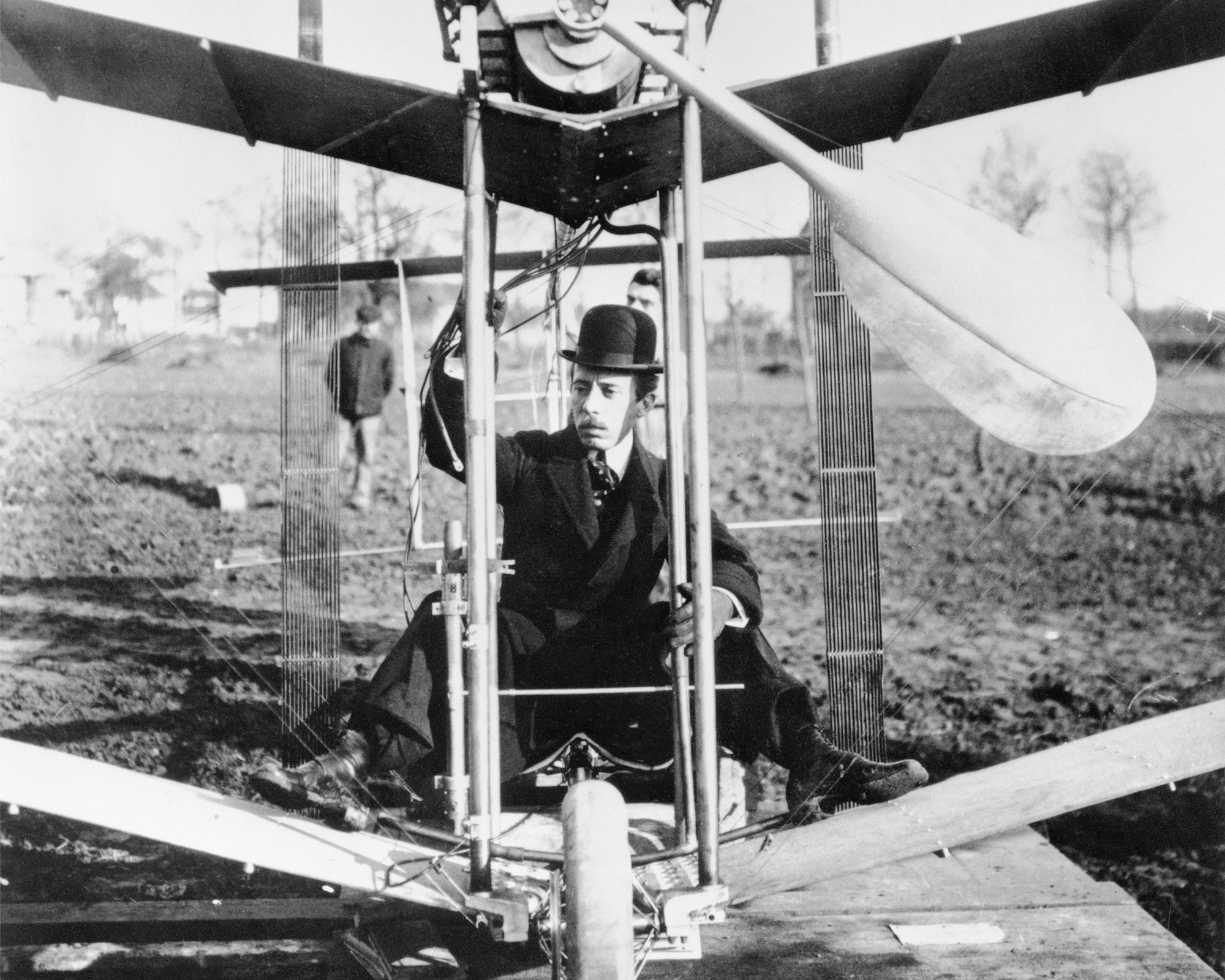
The aviation pioneer with his aeroplane, circa 1907
Credit © Cartier
Besides being a pioneer in the field of aviation, Santos-Dumont was very much a fashion icon. His trademarks included dark striped suits with rolled-up trouser legs, heeled boots, high collared shirts, and a Panama hat. His eccentric style further contributed to his fame, and he was featured in many magazines. There was such a hype surrounding him and his aircraft that his counter-free was printed onto various products, and apparel inspired by his style became available in boutiques. With his new wristwatch, the Brazilian attracted attention. His media impact sparked the Parisians’ interest, thus making the Santos increasingly famous. But what did the Santos look like?
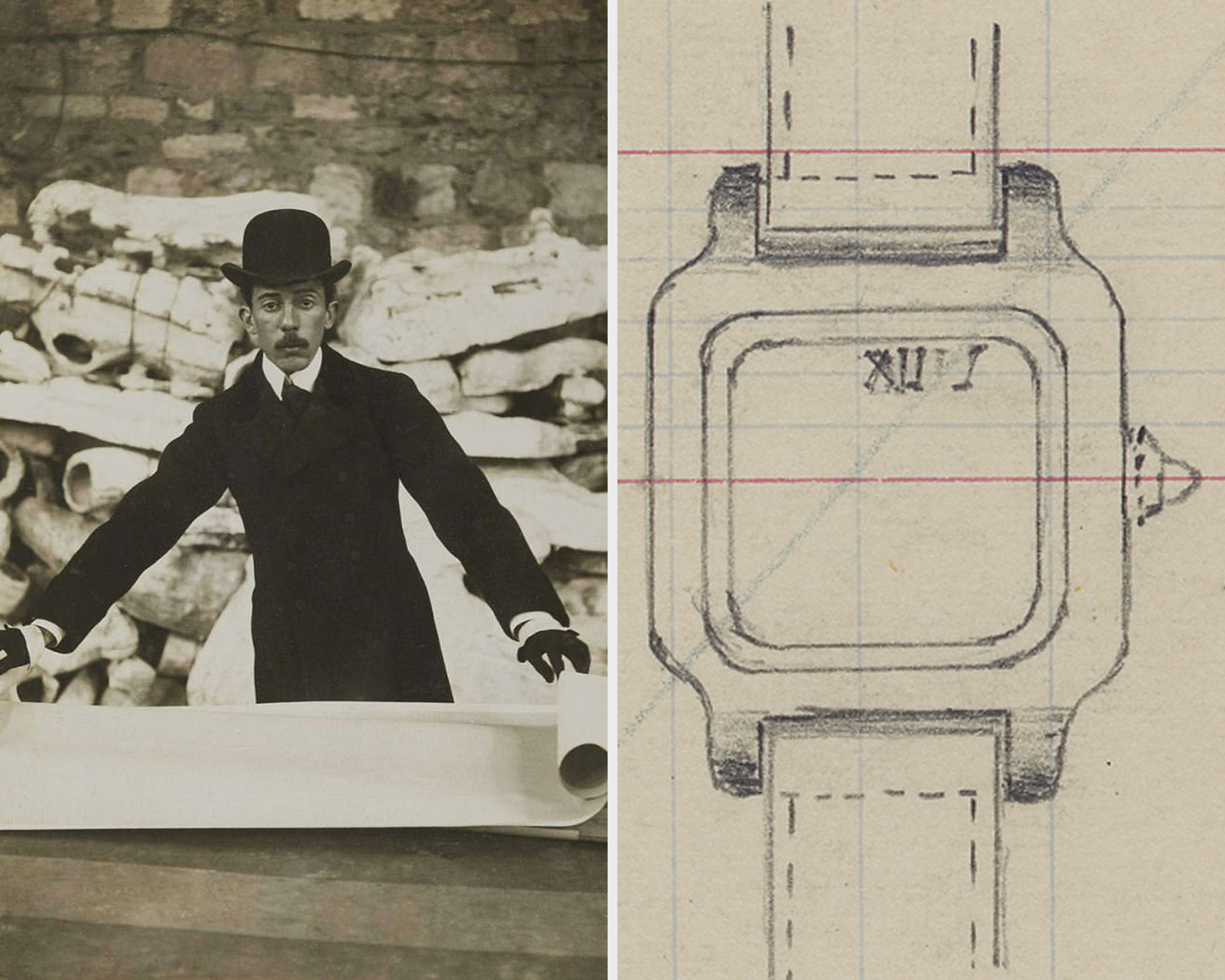
Credit © Cartier
The design of the Santos
Although this timepiece has unfortunately not been preserved, it can be regarded as a prototype for the watches that succeeded it. However, a few clues indicate that the watch resembled a sketch of a model named Santos II from 1908. The timepiece for Santos-Dumont was unique, but the interest and demand for wristwatches grew. When several wristwatches entered the market in 1911, Louis Cartier – as the smart businessman he was – decided it was the right time to market the wristwatch that Santos-Dumont had been wearing on his flights and that Cartier had secretly continued manufacturing. He named this model after his friend: Santos.
His ability to produce aesthetically pleasing and technically sophisticated creations helped Louis Cartier successfully reinterpret something initially intended for women for men. He used montre bracelets, watches that women wore on a black silk strap or a diamond-studded bracelet on their wrists, as an inspiration. Cartier had already made a few of them for his female customers. For men, however, there had to be a no-frills fastening that was more aesthetic than the wristwatches that had been made for the military.
Therefore, Louis Cartier created a square-shaped watch with a golden case, a sapphire cabochon on the right side, and lugs for secure attachment of the woven leather strap. The lugs for the strap were no longer separate items but part of the case. Thus, the strap was not just a feature but part of the whole, making Cartier’s exceptional watch the first watch created for the purpose of wearing it on the wrist. In this sense, it was the ‘first modern watch’, according to Franco Cologni’s book The Cartier Tank Watch. In 1911, the timepiece was available with either a black or brown leather strap.
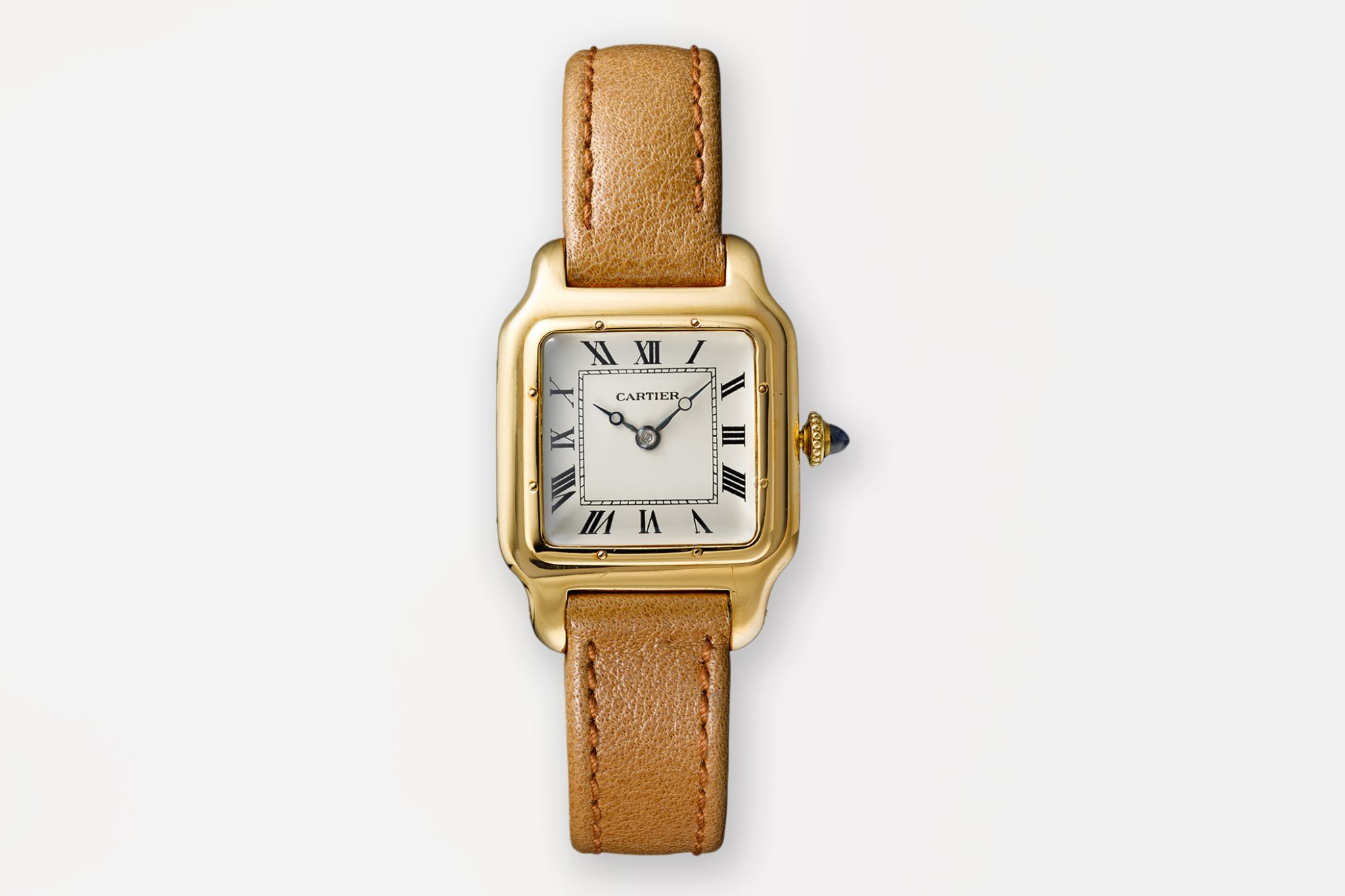
A Santos-Dumont with a brown leather strap from 1912
Credit © Cartier
Moreover, the watch’s square shape reflected a new zeitgeist, as a round case was the most common shape at the time. At the beginning of the 20th century, designers experimented with different lines, angles, and cuts. Thus, the first watches also came in different shapes. For the Santos-Dumont, Louis Cartier opted for an angular shape. In 1906, jewellery creations with angular shapes had already been offered by Cartier. In 1908, angular pocket watches, such as a pocket watch with a chain made of platinum with a ruby cabochon, followed. By playing with straight lines and clear shapes, Louis Cartier’s designs represented a modern style, which was reflected in the Cubism movement flourishing from 1907 onwards. Following this geometric aesthetic, the first commercial Santos-Dumont had a square-looking 35 x 25 mm small, flat case. The corners of the case were rounded, and their extension seamlessly segued into the lugs. Thus, the case and the strap attachment were of one piece. The case was available in yellow gold or platinum, which Cartier had been the first company to use for its creations since 1860 and for its famous Tonneau watch in 1906. The use of platinum was yet another sign of Cartier’s modernity.
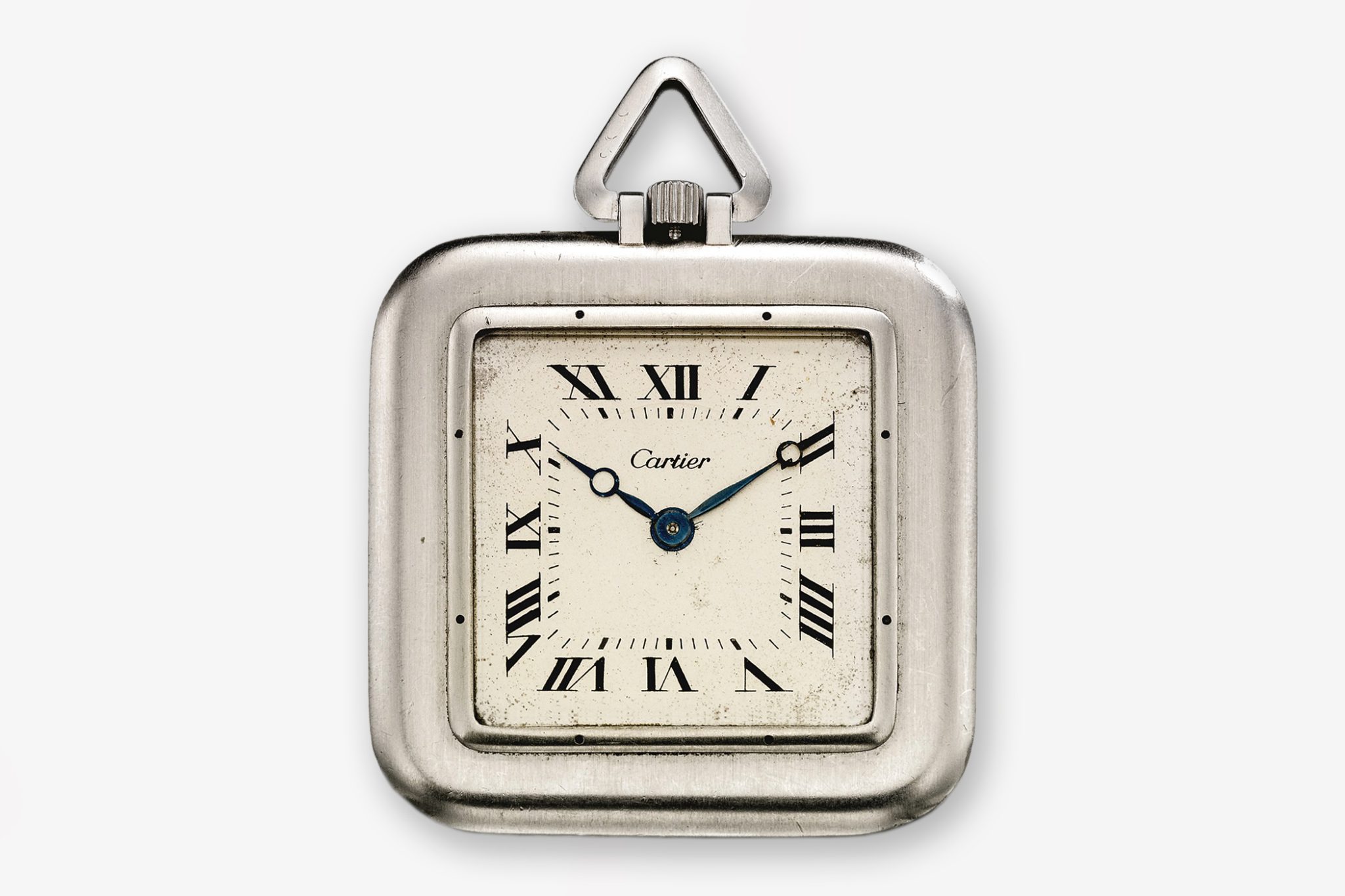
A platinum Cartier pocket watch from the 1910s
Credit © Sotheby’s
The eight visible rivets, later screws, on the bezel with a rehaut have also become an unmistakable hallmark feature, and were highly unusual at the time. Together with the shape of the case, they are supposed to evoke a bird’s eye view of the Eiffel Tower’s imposing structure in an abstract form. Thereby, Louis Cartier picks up on the perspective that Alberto Santos-Dumont must have had from up above in his dirigibles. Moreover, the dial also pays homage to the French capital viewed from above. The blackened, slender Roman numerals that were to become characteristic of the maison are modelled on the new cityscape of Paris, which had changed significantly in the 19th century. In a 17-year process between 1853 and 1870, Baron Georges-Eugène Haussmann had a large part of the city demolished and rebuilt from scratch on commission by Napoleon III. His radical approach created the long, broad avenues and beautiful facades that make up the city as we still know it today.
In addition to the timepiece’s modern design and the allusions to flying, the model is a good example of the successful collaboration between Cartier and the watchmaker Edmond Jaeger. Established in 1907, the contract for the cooperation guaranteed Cartier exclusive rights. As a specialist for miniaturising movements, Jaeger always found a suitable technical solution to adapt a movement to a case shape. This meant that there were no limits to Louis Cartier’s design.
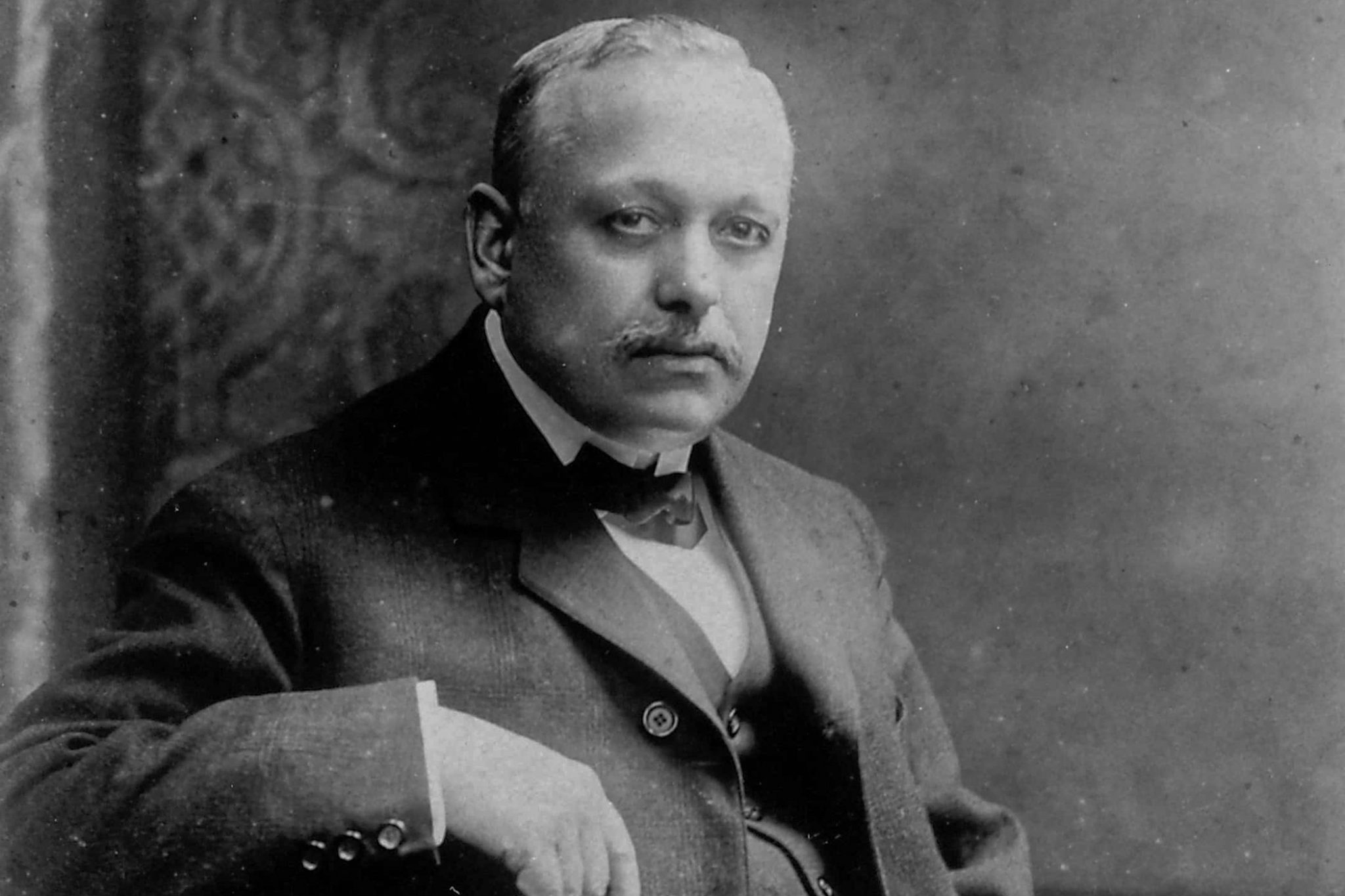
Edmond Jaeger
Credit © Cartier
Likewise, Edmond Jaeger created the movement for the Santos-Dumont. In addition, he equipped the model with a gold folding clasp that he had invented and patented. Cartier first used his invention in 1910 and the company’s employee Joseph Vergely further developed it into its current D-shape. Within the industry, this folding clasp was a novelty and rounded off the very advanced-looking Santos model.
Further developments of the Cartier Santos
The Santos has left a lasting mark on Cartier’s image and established the maison as an innovative watch manufacture, simultaneously revered for its timelessly designed classics. Since 1911, the timepiece has appeared in countless forms. However, the watch has remained faithful to its distinct design DNA. Compared to other models, it has hardly changed its name throughout the century. Let us now take a closer look at the later history of the Santos.
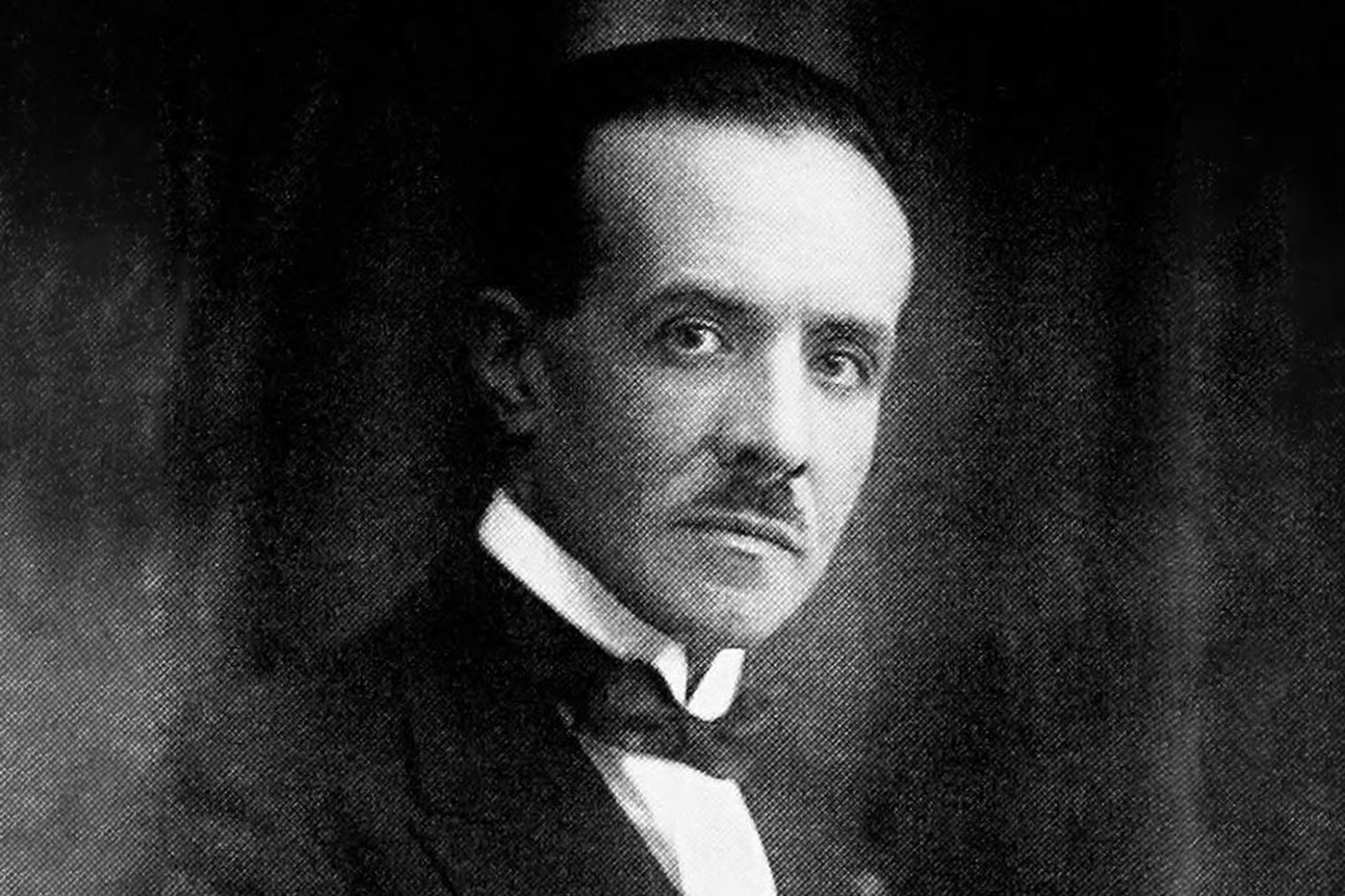
The fashion designer Jean-Charles Worth liked to wear a Santos, circa 1920
Made alluring by Santos-Dumont, wristwatches enjoyed increasing popularity – especially during the First World War. In 1930, sales of wristwatches surpassed those of pocket watches. However, interest in the Cartier Santos watch waned in the 1940s, as its square case did not comply with military regulations that wristwatches had to be round. The turning point came in the 1970s and onwards, when Cartier wanted to appeal to a broader clientele and the Santos experienced a boom. Alain-Dominique Perrin, who was appointed marketing director in 1969 and general manager of Briquet Cartier SA in 1973, played a major role in achieving this. The year he became General Manager, the Santos made a comeback as a foundational part of the Collection Louis Cartier, based on iconic models from Cartier’s history. At the time, the watch was launched in 18-carat gold with a leather strap and folding clasp as a men’s and women’s edition.

Alain-Dominique Perrin
But it was in 1978 that the Santos experienced a meteoric rise. Under Perrin, Cartier launched the Santos as an affordable sports watch to compete with Audemars Piguet’s Royal Oak and Patek Philippe’s Nautilus. To do so, Cartier used a material that the maison had never before utilised for its watches: stainless steel. The 29 mm x 41 mm case was first released in a bicolour version. While the case was made of stainless steel, the screws in the integrated bracelet and the bezel were made of 18-carat gold. Using two different coloured metals in this way was a novelty at that time. Cartier was one of the first companies to use this combination of materials and colours.
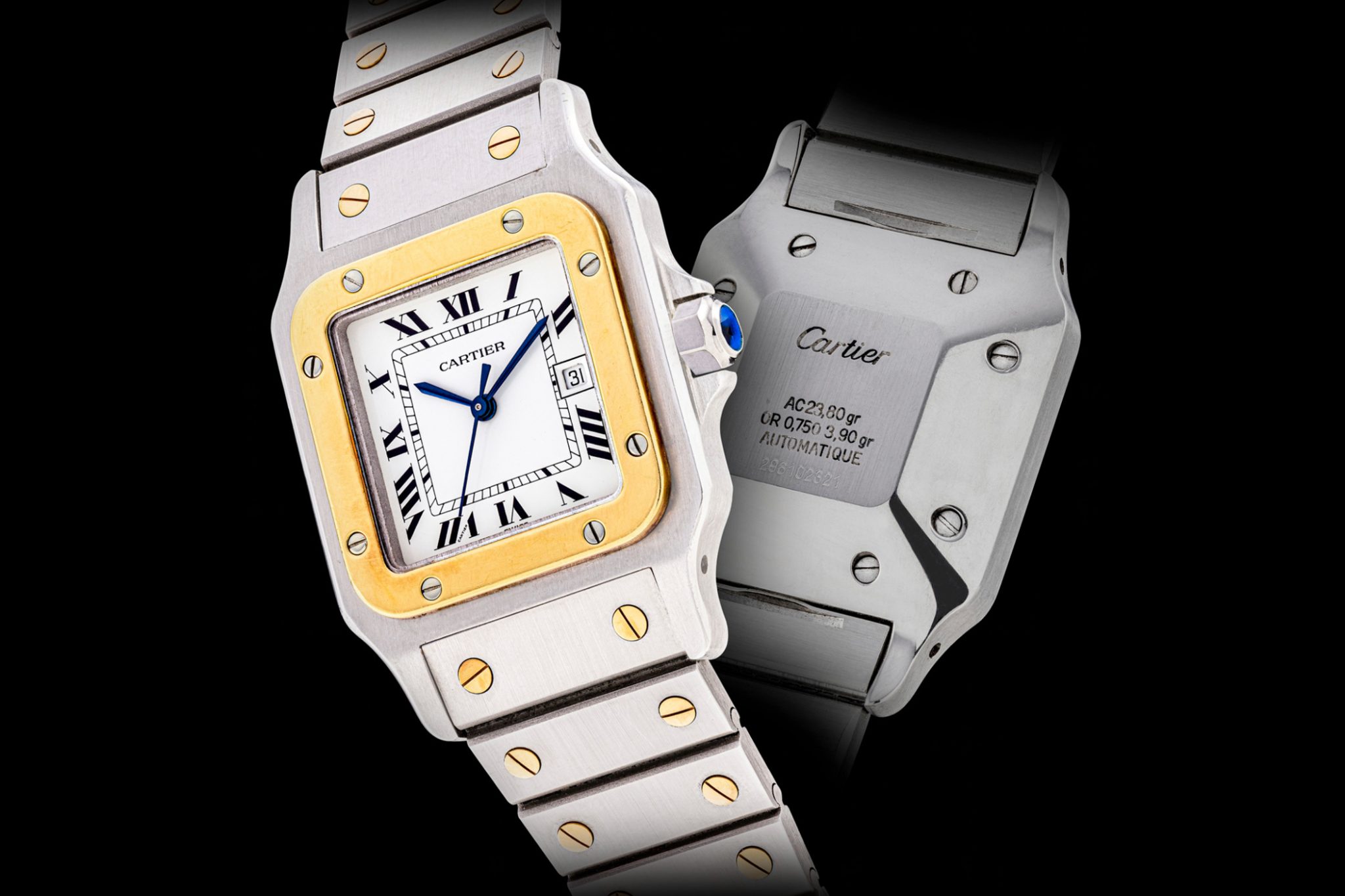
A Santos with a date display, circa 1979
Credit © Christies
On 20 October 1978, the watch was launched at the Musée de l’Air, which holds much symbolic meaning given Alberto Santos-Dumont’s Demoiselle can still be admired there today. Throughout the 1980s, the watch proved a great success. In fact, it was so in demand that it often fell victim to counterfeiting. Between the 1970s and 1980s, the watch was released in all-steel versions, with moon phases and even an octagonal case in addition to the bicolour edition. In 1979, Cartier hosted a dazzling party to celebrate the 75th anniversary of the Santos and the launch of its new collection in Manhattan. The chic, high society ‘Santos Night’ was attended by 500 guests, including writer Truman Capote and designer Bill Blass, while the renowned Parisian DJ Castel put on music in a hot air balloon.
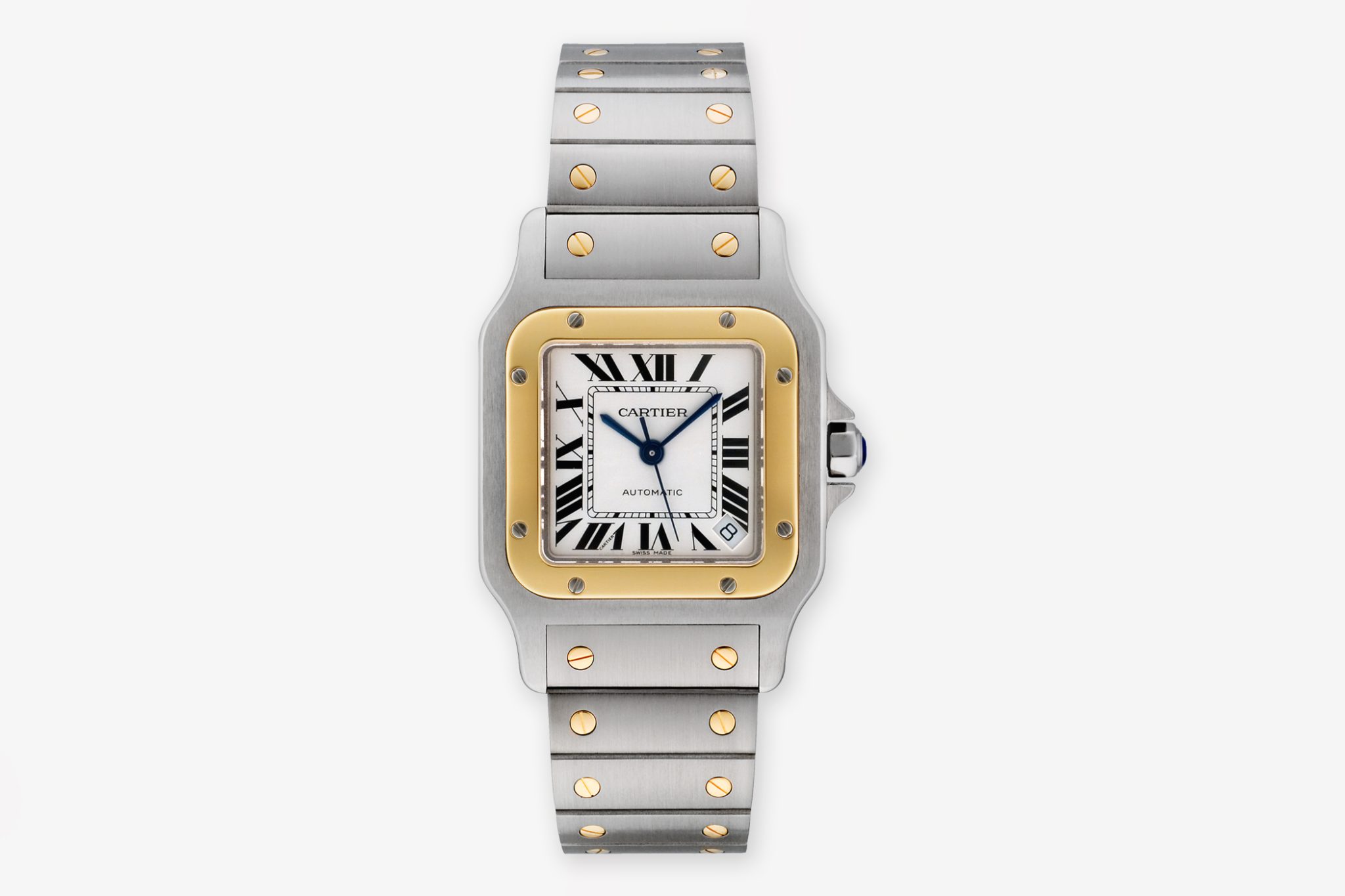
A Santos Galbée from 1987
Credit © Cartier
In 1987, the design of the Santos de Cartier was slightly modified by making the lines softer and more curvaceous. This design has been retained to this day. From then on, the watch was called Santos Galbée. Strictly speaking, all subsequent Santos de Cartier models are Galbées. The various Galbée models were mostly offered with a quartz movement. Still, from time to time, there were also editions with a mechanical movement, such as the Galbée from 2002, limited to 2,000 pieces, with a grey dial and the calibre 2000.
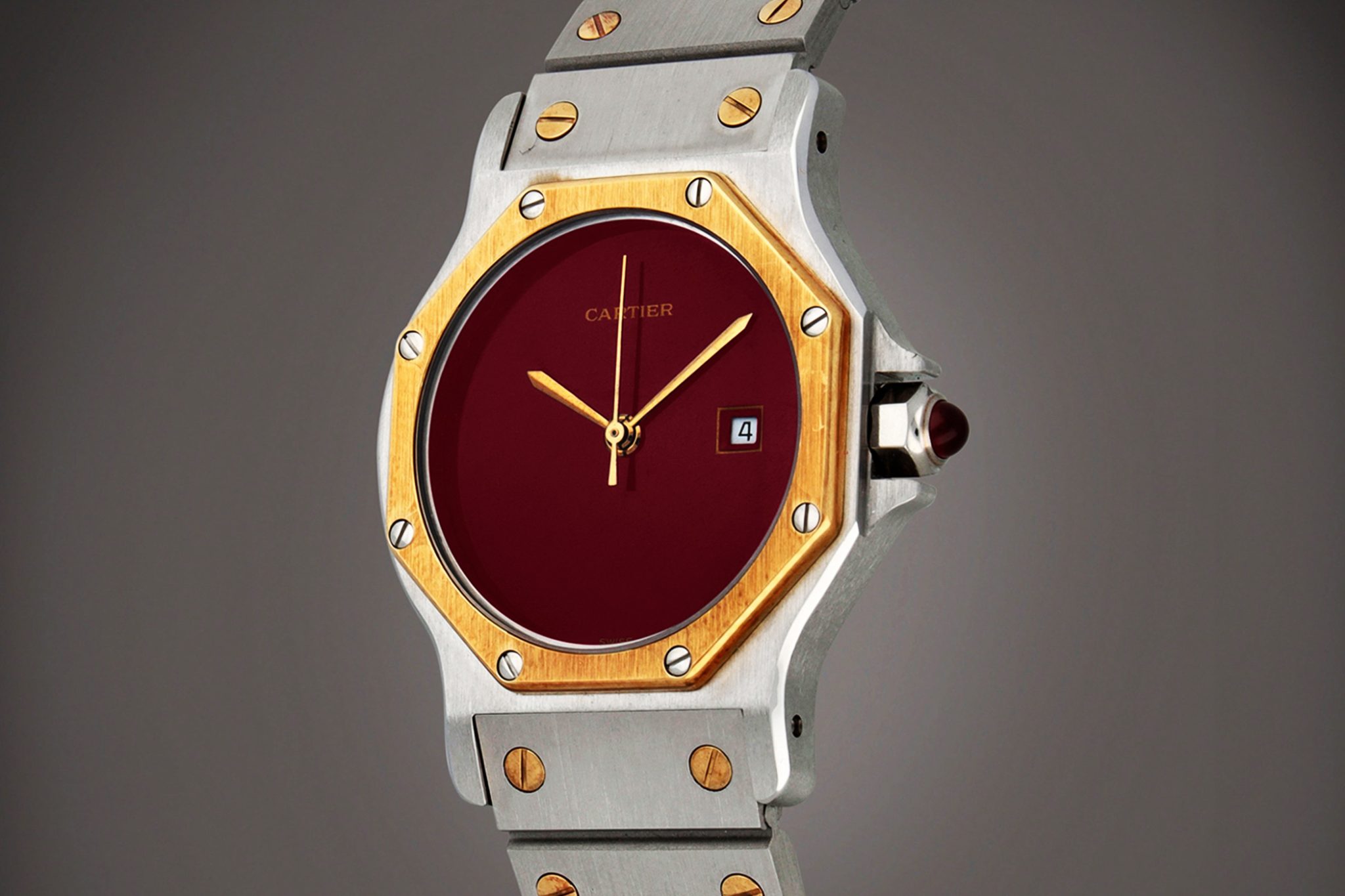
A Santos Octagon with date display, ca. 1990
Credit © Sotheby’s
Distinct designs mainly characterise the development of the timepiece in the 1990s. For example, the Santos Octagon from 1990 stayed true to the aesthetic of the Santos with its screws. Yet, in keeping with its name, the case was no longer square but octagonal. In 1997, the Santos-Dumont 1575 Ultra Thin Special Limited Editionappeared with a platinum 4.3 mm-high case and the ultra-thin 021 MC movement based on a Frédéric Piguet 21 calibre. With its blue alligator leather strap and salmon-coloured sunray guilloché dial, the timepiece was a true eye-catcher and limited to 1,997 pieces. The following year saw the launch of the Collection Privée Cartier Paris, which ran for ten years. Here, Louis Cartier’s creations were revived with larger cases. Some models were limited to 100 pieces, but even without limitation, only 200-250 pieces were produced. However, these were not manufactured in-house, and the components came from various suppliers. Well-known manufacturers such as Piaget, Gerald Genta or Frederique Piguet provided the movements with a Cartier finish.
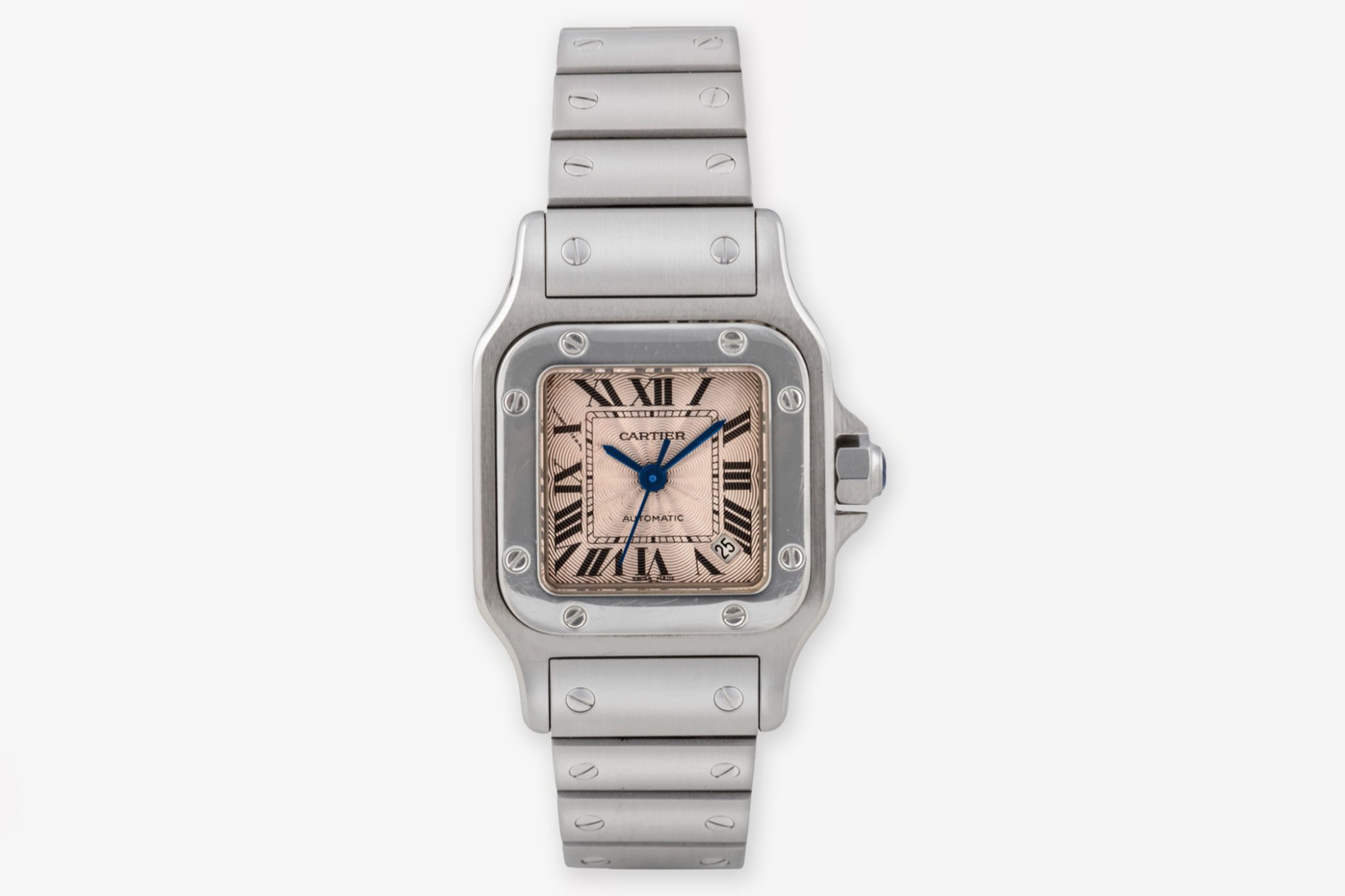
A Santos Galbée (Ref. 2423) with an improved date display for women, circa 2001
Credit © Christies
Moving forward to the 21st century, there were a few changes. Firstly, there was an edition with a movement by Piaget and a lengthened case that lacked the iconic screws. Secondly, Cartier adapted its range to the high demand for larger watches and launched the two-tone Santos Galbée XL in steel and gold. This was the first reissue of the Galbée since its appearance, with an improved date display now placed between 4 and 5 o’clock instead of 3 or 6 o’clock.
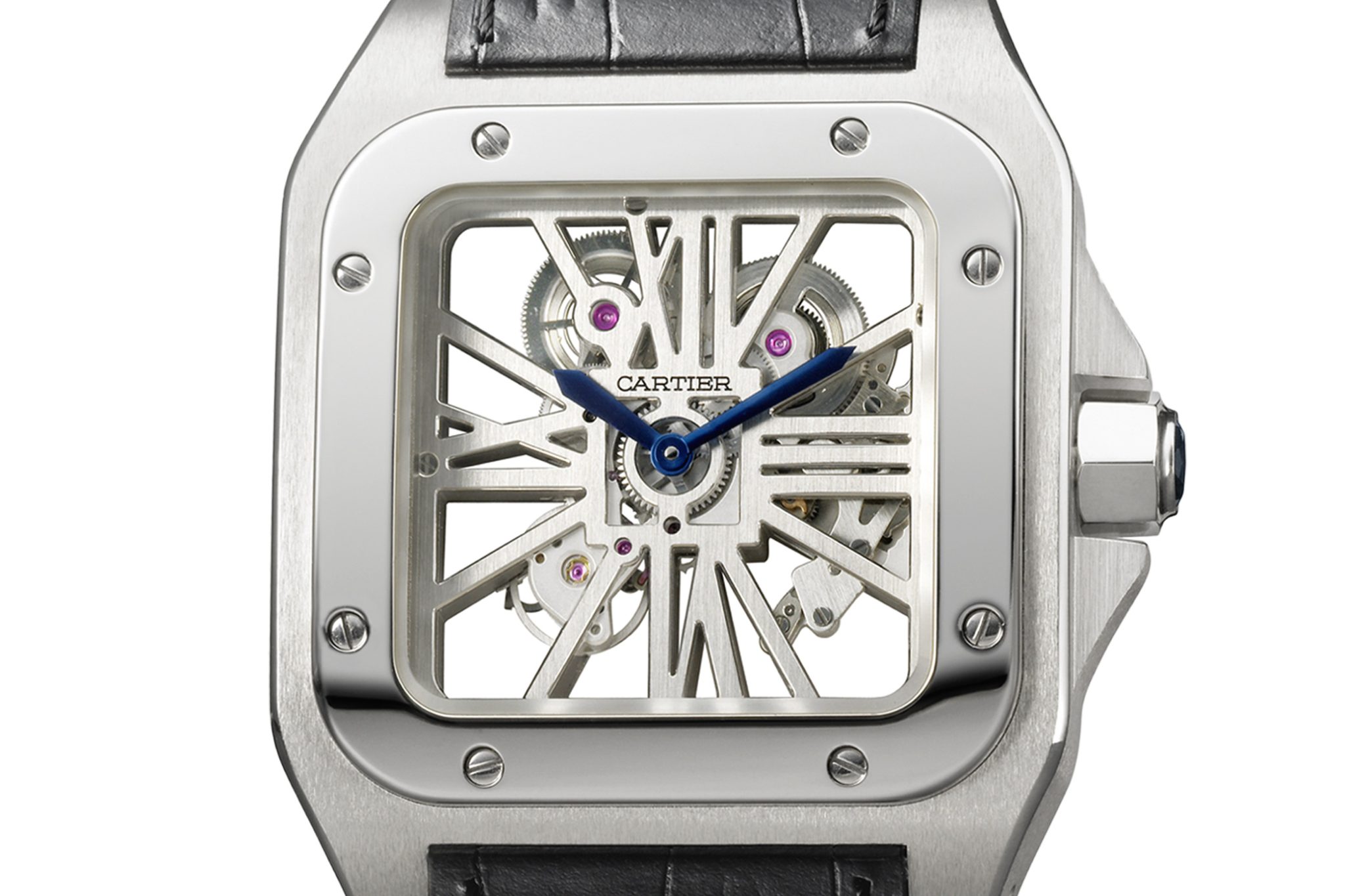
A Santos 100 Skeleton (W2020018)
Credit © Cartier
To celebrate the 100th anniversary of the wristwatch, the Santos 100 collection was released in 2004. The collection included timepieces with a wide range of material and strap variations and was continued until 2017. Customers could choose between a medium (square with 35.6 mm) and large size (51 x 41 mm incl. crown). The simple steel edition housed the calibre 049 or 076, depending on the size. The collection also included chronographs in blackened titanium with a steel bezel or a skeletonised version with a 9611 MC calibre from 2009, which could be admired via the open caseback. The latter version was equipped with skeletonised bridges that also functioned as Roman numerals to indicate the time, giving the watch an Art Deco appearance. In 2007, Cartier launched the Cartier Fine Watchmaking Collection, which remained on the scene for ten years. The first watch of the collection was the Santos 100 Tourbillon, with a very large 46.5 x 54.9 mm case and the in-house calibre 9452 MC, which is very small compared to the case. However, the fact that the case and the calibre each have a different serial number makes this model difficult for collectors. Overall, there was a variety of Santos watches in the early 2000s, most of which were equipped with quartz or automatic movements. In 2012, there were only two men’s models left that featured a mechanical movement.
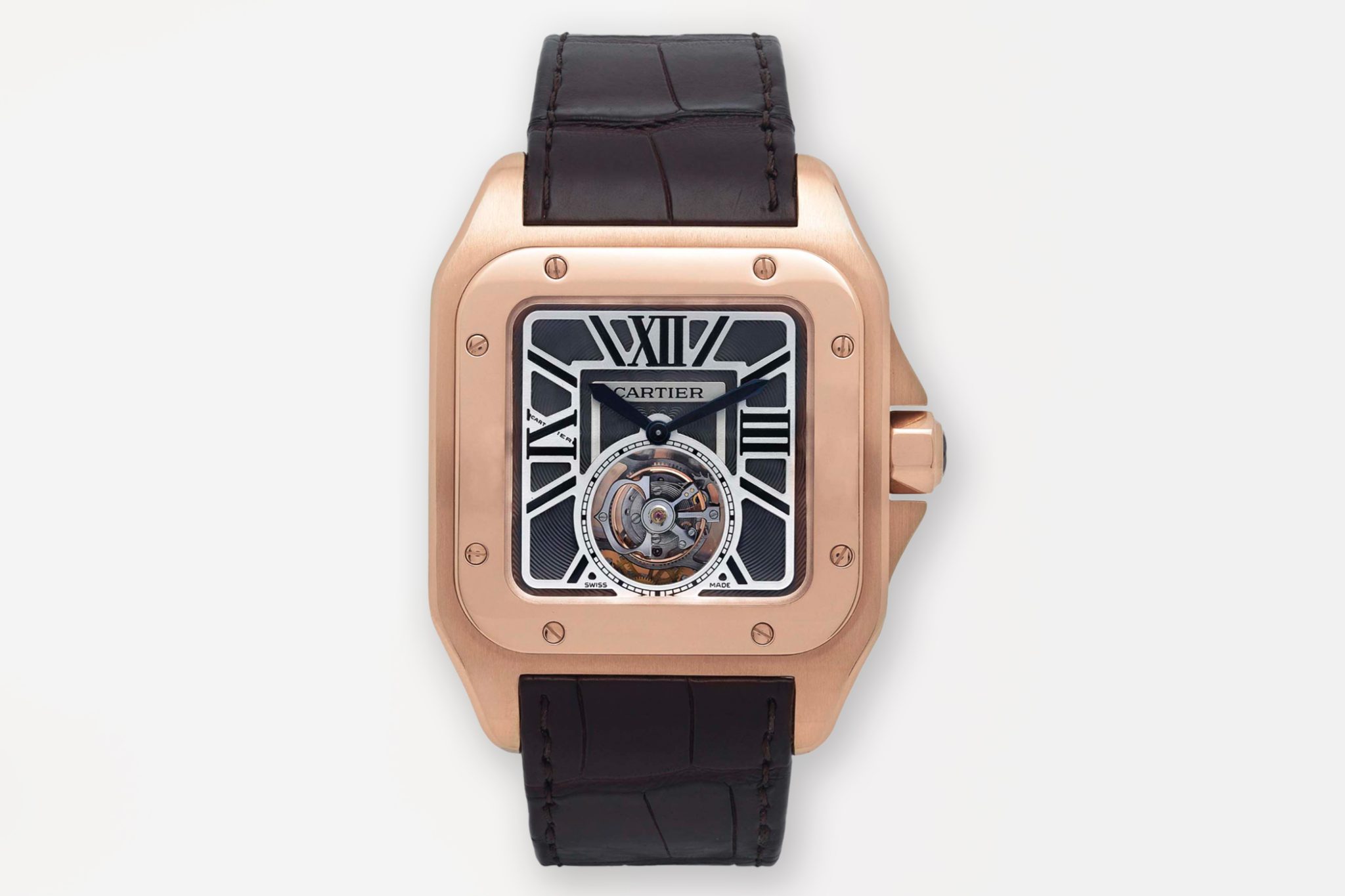
A Santos 100 Flying Tourbillon (Ref. W2020019) from 2010
Credit © Christies
Eventually, Cartier caused a big stir in 2016 when all Santos models were taken off the online shop and the remaining examples were sold out in the boutiques. It turned out that Cartier had planned to revise and reissue the Santos. In 2018, the time had come. The relaunch comprised 12 models, including two skeletonised versions. The case and sapphire crystal silhouettes were now more curvaceous, and the brushed case was additionally polished for a more refined look. A selection of sizes was also offered, which still holds true today. Clients could choose between medium (35.1 mm x 41.9 mm) or large (39.8mm x 47.5 mm), with the sizes differing in price by only 600 euros at the time, and the large size displaying the date at 6 o’clock. The models featured an in-house developed and manufactured Calibre 1847 MC, which was originally introduced in the Clé de Cartier collection. With the QuickSwitch system and SmartLinks there were two additional innovations. While the QuickSwitch system made it possible to easily switch between the calfskin, alligator leather, or stainless-steel straps, the SmartLinks (for stainless steel bracelets) enabled an altering of the bracelet length.
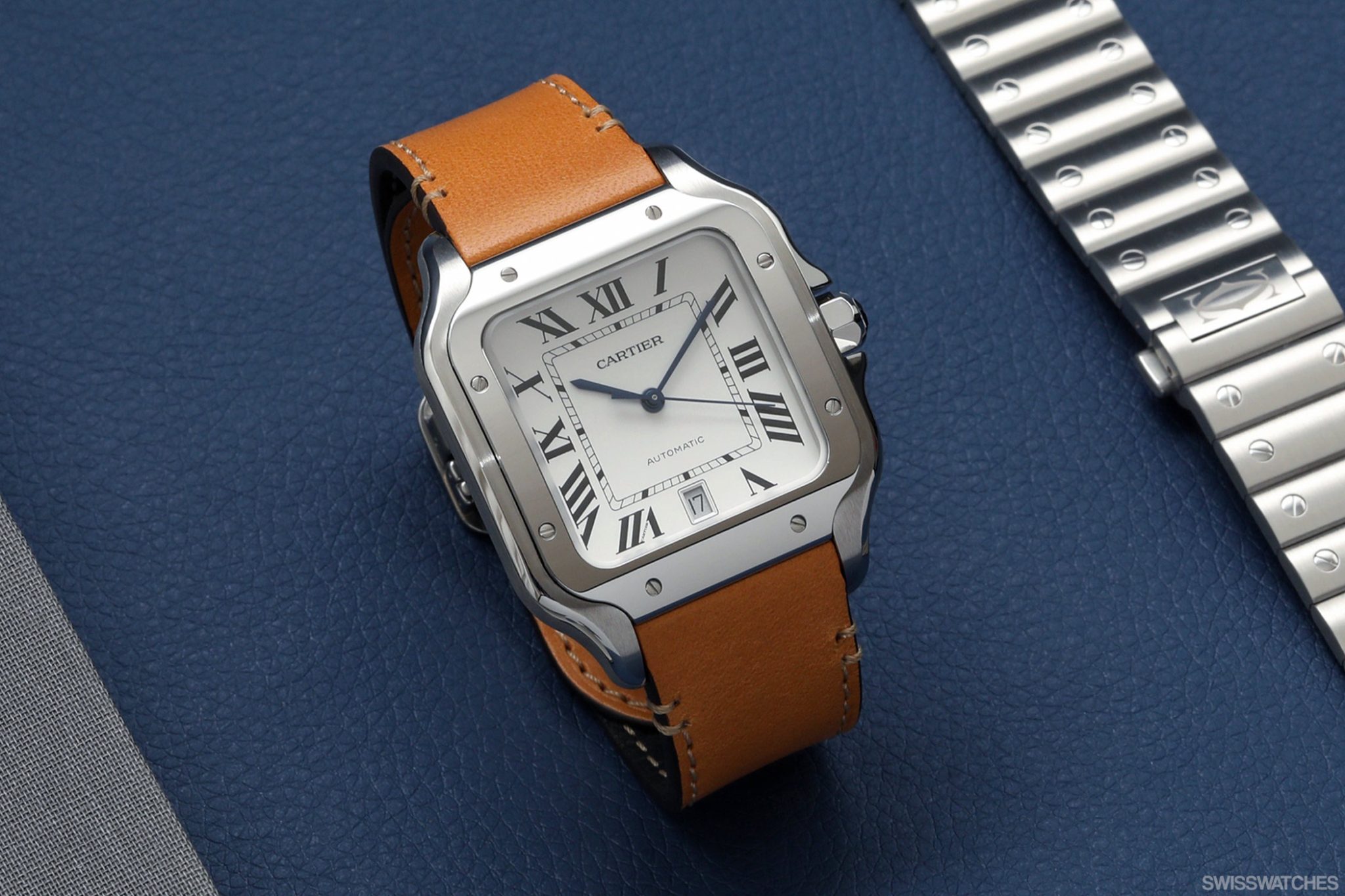
The QuickSwitch system allows an easy exchange of straps
Thanks to the relaunch, the Santos is now available in different sizes for both men and women as two series: The Santos-Dumont and the Santos de Cartier (formerly Galbée). With its flat case and smaller sizes, such as a 38mm x 27, 5mm case, and a leather strap, the Santos-Dumont is based on the original model created for the aviation pioneer. In 2019, several versions of the Santos-Dumont appeared with a larger crown and a leather strap. For example, there was an automatic watch with three hands and a chronograph, a skeletonised version, and one with a durable quartz movement which batterie lasts for around six years. According to the late George Cramer, the thinner typography used for the indices resembles a model from 1916. In the same year, the Santos Chronograph editions were made of various metals, including yellow-gold or rose gold bezels.
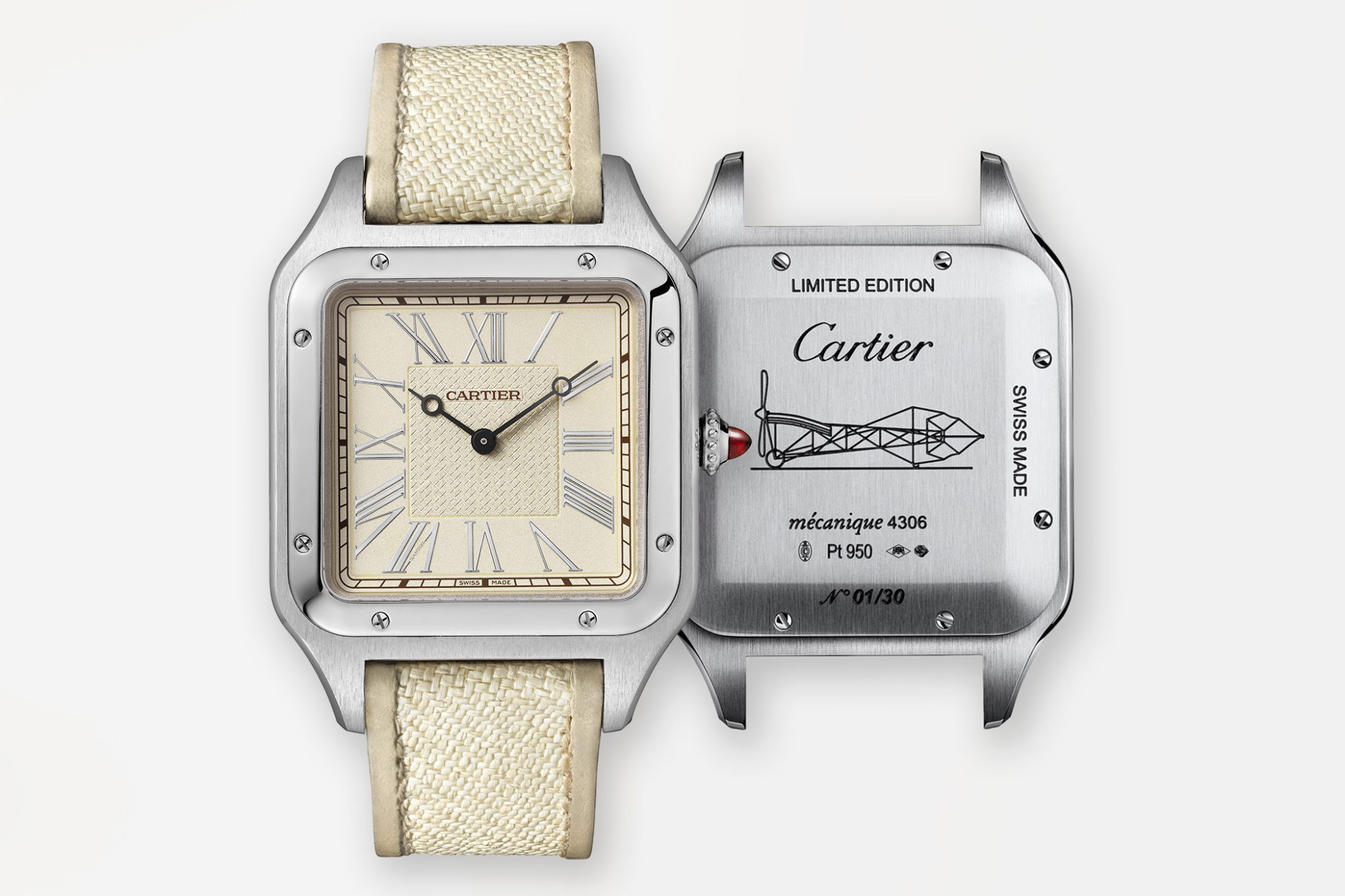
The Santos La Demoiselle Limited Edition with an engraving of the aircraft on its caseback
Credit © Cartier
Unlike the Santos-Dumont, the Santos de Cartier is based on the modified 1987 design and has a larger, more eye-catching case with a bezel-set crown instead of an exposed one. A date display is also available depending on the size. While the Santos de Cartier remains water-resistant up to 100 metres, the Santos-Dumont is only water-resistant up to 30 metres. In 2020, a Santos de Cartier in all-black with ADLC coating was released with a rubber strap. The same year also saw the release of the Santos La Demoiselle Limited Edition, limited to 30 pieces. The timepiece consisted of an XL-sized case with a ruby cabochon instead of the usual sapphire, an ecru colour palette, a Panama strap, and an engraving of the Demoiselle on the caseback. That year, the Santos-Dumont Limited Edition 2020 was released as another limited edition and was equipped with a mechanical 430MC calibre.
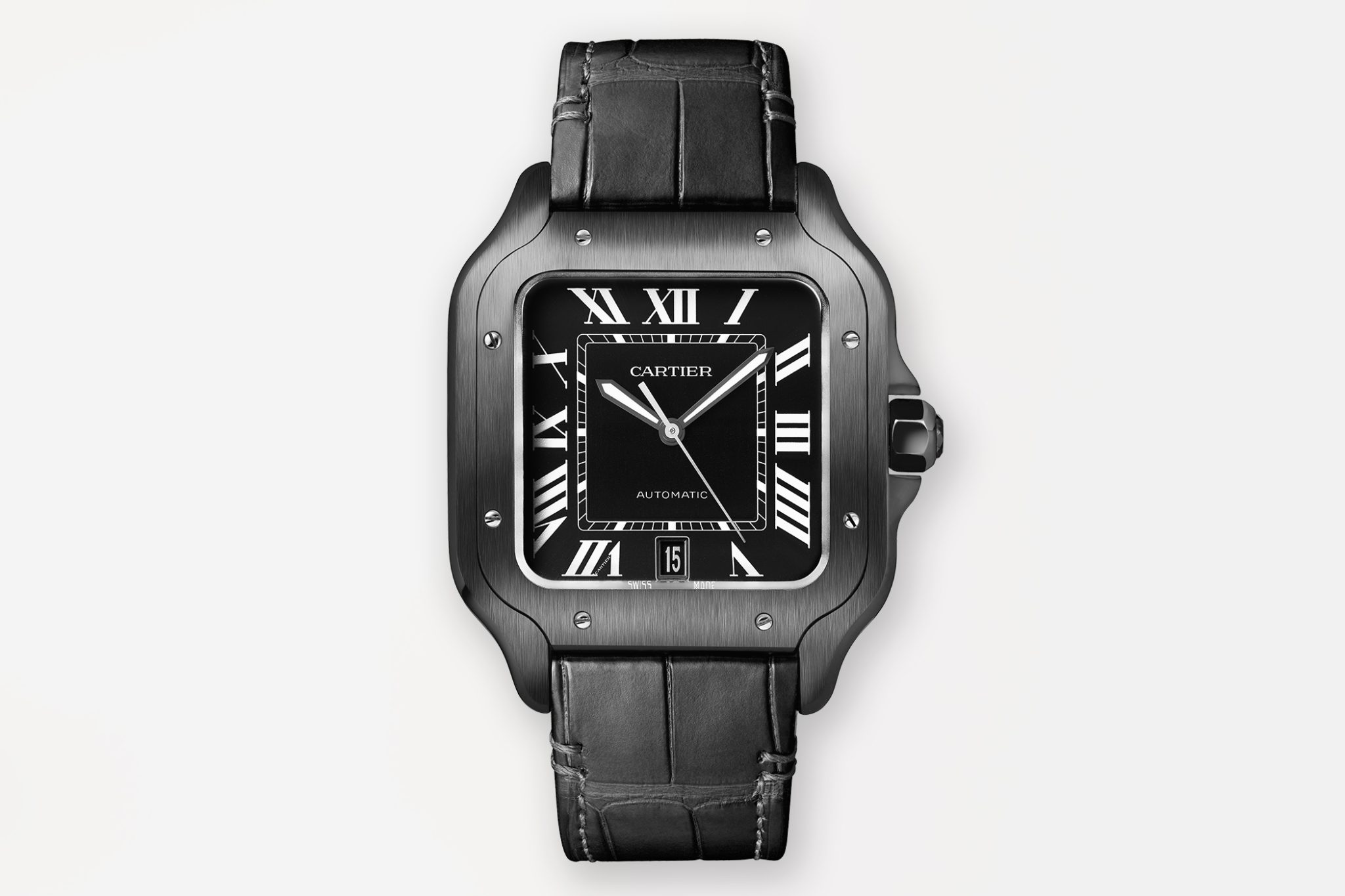
A Santos de Cartier made of steel with an ADLC-coating
Credit © Cartier
From different gold variations, steel and titanium, from the ADLC-coated case to the diamond-set bezel – there are no limits when it comes to the combination of materials for the Santos collection. A wide selection is on offer, both in terms of size and price. For 4,200 euros, customers can already buy a small Santos-Dumont with a steel case and quartz movement. The most elaborate models are the skeletonised versions with a mechanical or self-winding movement. For example, the skeletonised Santos de Cartier in 750 rose gold is currently the most expensive Santos watch, with a 73,000 euro price tag.
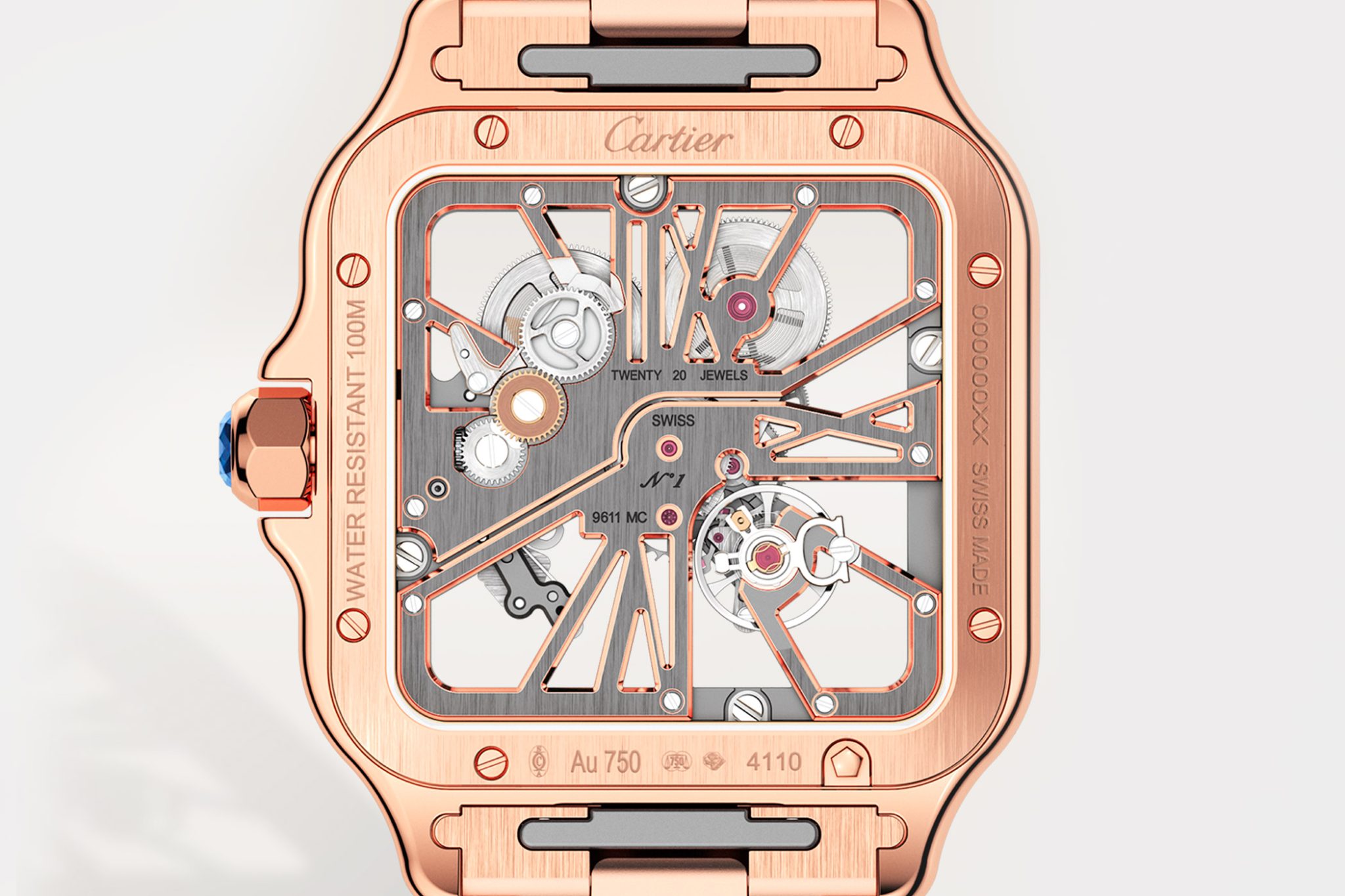
Currently, the Santos with the biggest price tag: a Santos de Cartier made of rose gold
Credit © Cartier
For those who have not found the right Santos watch among the large selection, there is also an option of having your Santos personalised. However, it can take up to three years until the customer can admire the watch on his wrist. For example, Bader Belselah, one of the best-known collectors from the United Arab Emirates, had a Cartier Santos made with an elegant rose-gold case, a wine-red dial with Arabic indices and a matching strap.
The Cartier Santos on the watch market
How does the Cartier Santos fare on the market? In principle, many of Cartier’s precious creations retain value, as the prestigious brand’s products are highly recognisable. The Santos remains one of the most sought-after watches on the secondary market. While the steel versions maintain their approximate value, there is less interest in the gold versions. Although these lose value quickly, they can prove to be a good investment on the secondary market. Limited editions and vintage pieces are particularly in demand, with very early Santos models being rare finds. Nevertheless, the well-known late watch collector George Cramer fervently recommended the Santos as an investment, especially for young collectors starting out.
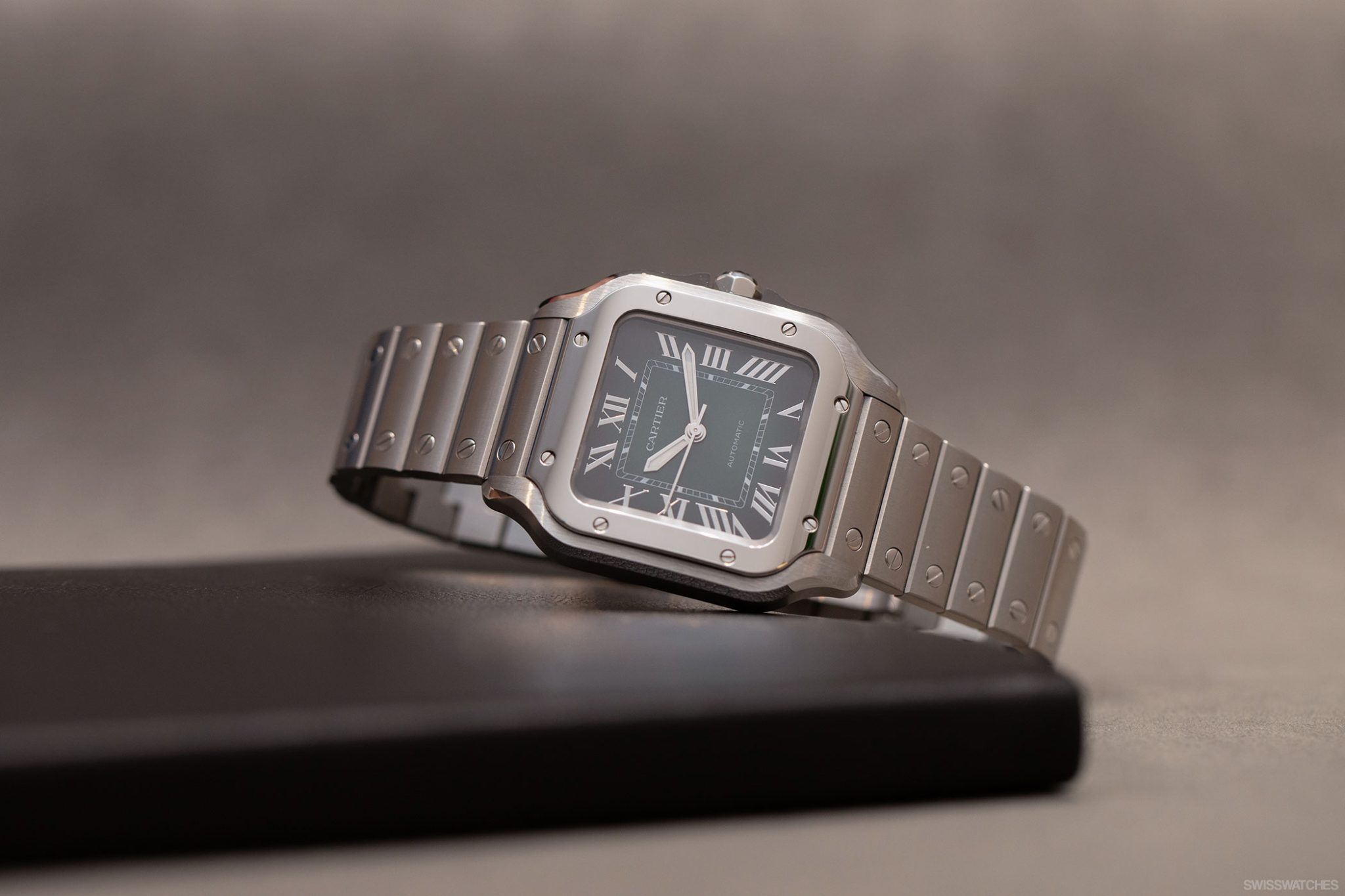
Santos de Cartier watch, medium model, mechanical movement with automatic winding 1847 MC. Ref. WSSA0063
Who wears the watch?
The Santos’ linear design makes it a timeless watch, regardless of the edition, while the QuickSwitch system adds versatility. Because it is striking and unobtrusive at the same time, the Santos can be worn on casual, everyday occasions or in combination with a suit for a sporty, elegant style. Two pop-culture examples from the 1980s show how versatile the timepiece is: in Wall Street, Michael Douglas plays the banker Gordon Gekko, who elegantly pairs a gold Santos with a suit, braces, and tie for the office. On the other hand, Jerry Seinfeld casually combines the steel version with a black pullover in his acclaimed sitcom Seinfeld.
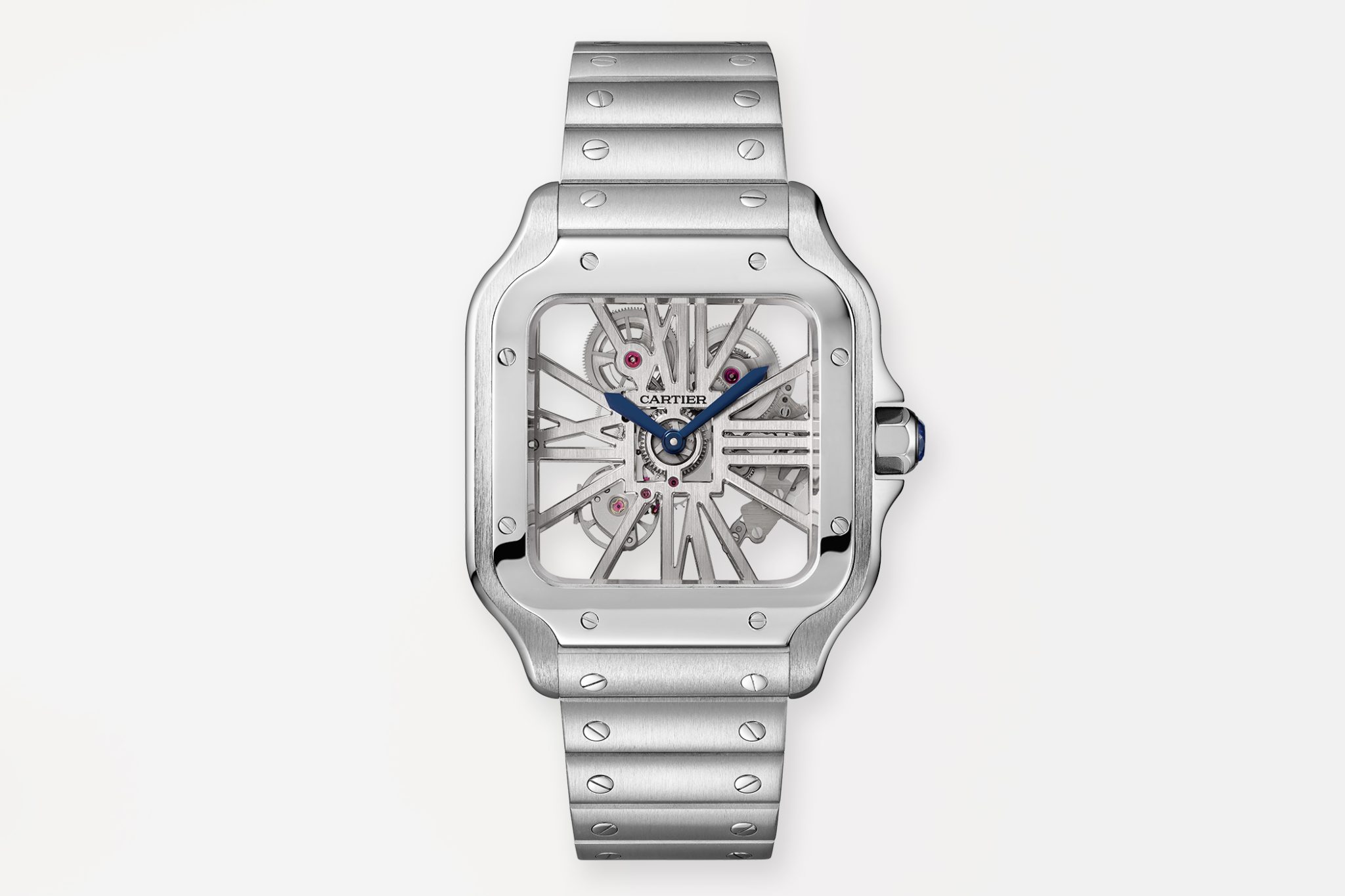
Oscar winner Daniel Kaluuya wore this Santos de Cartier Skeleton model from 2018 on the red carpet of the Oscars
Credit © Cartier
The Cartier Santos is also a popular and frequently seen guest on red carpets. For example, British actor and Oscar winner Daniel Kaluuya wore a skeletonised stainless-steel model at the 2021 Oscars. Actor Adrian Brody presented a large yellow gold Santos on the infamous carpet of the 2022 Met Gala, and a Cartier Santos-Dumont graced the wrist of director Taika Waititi at this year’s fashion event. The aforementioned George Cramer, who loved to collect Cartier watches, was also very fond of the Santos. In an interview, he explained that a stainless-steel Santos was his first watch and that it had ignited his passion for collecting. The gifted collector liked to wear a Santos Galbée XL during the summer months.
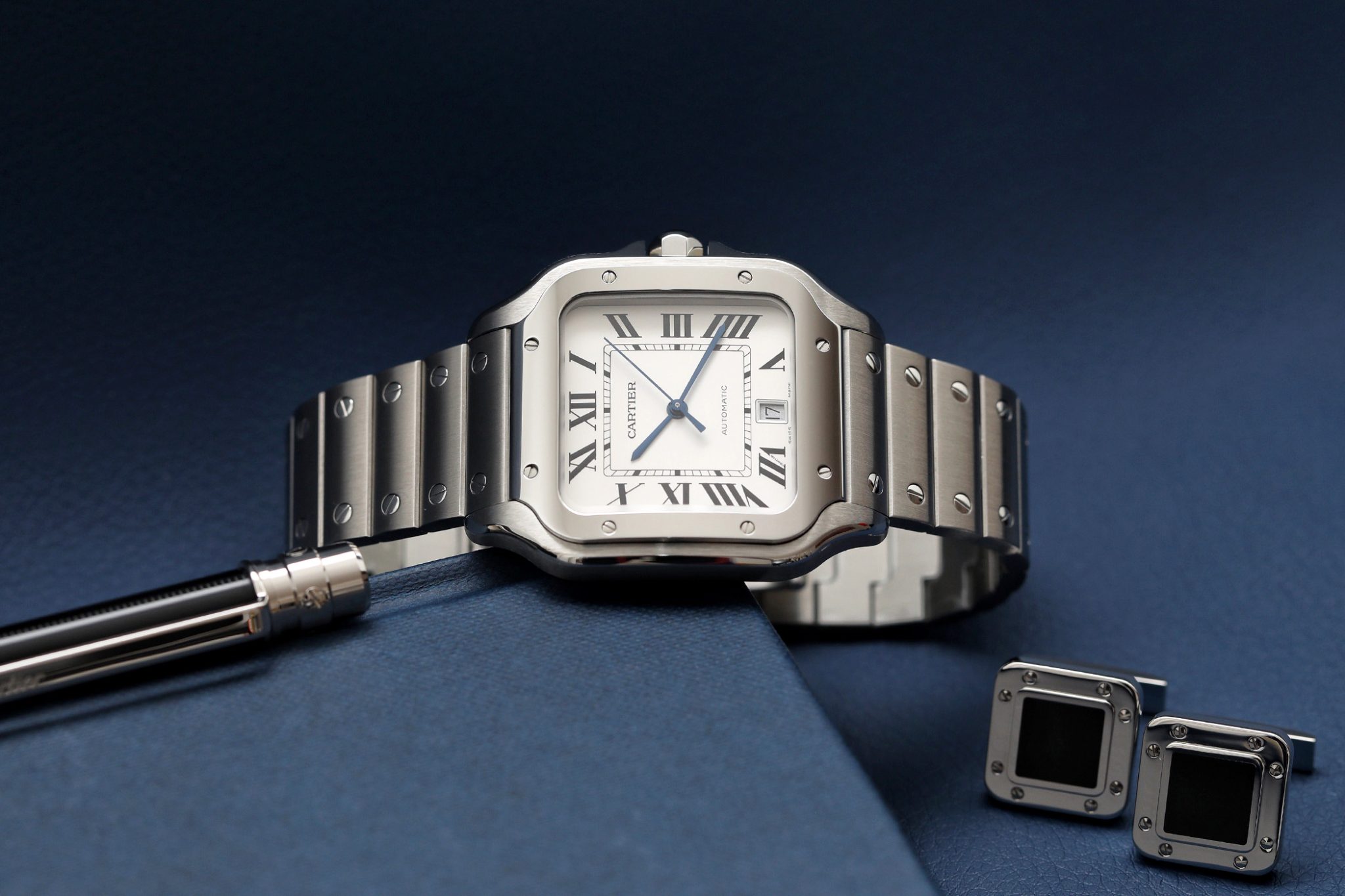
Whether on the red carpet or in everyday life, the Santos has become a symbol of how much we take watches for granted on our wrists these days. While over than a hundred years ago, a watch on the wrist would have genuinely drawn criticism, today, people enthusiastically which wristwatch someone is wearing. The fact that such a watch is now considered a constant companion and statement piece for men is owed to Alberto Santos-Dumont’s bold, pioneering spirit and Louis Cartier’s inventiveness. Although Alberto Santos-Dumont’s life came to a tragic end, the Santos undoubtedly immortalized him. With its avant-garde design that has stayed so true to its original, the Santos still bears witness to a time when the world moved at breakneck speed. High up in the air, Santos-Dumont made history with his wristwatch, and now many are continuing his story, with a watch steadfastly strapped to their wrist.
